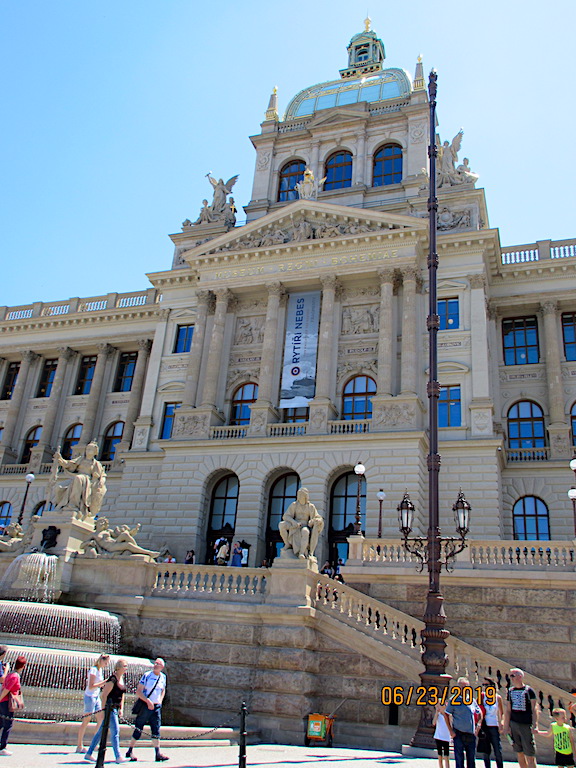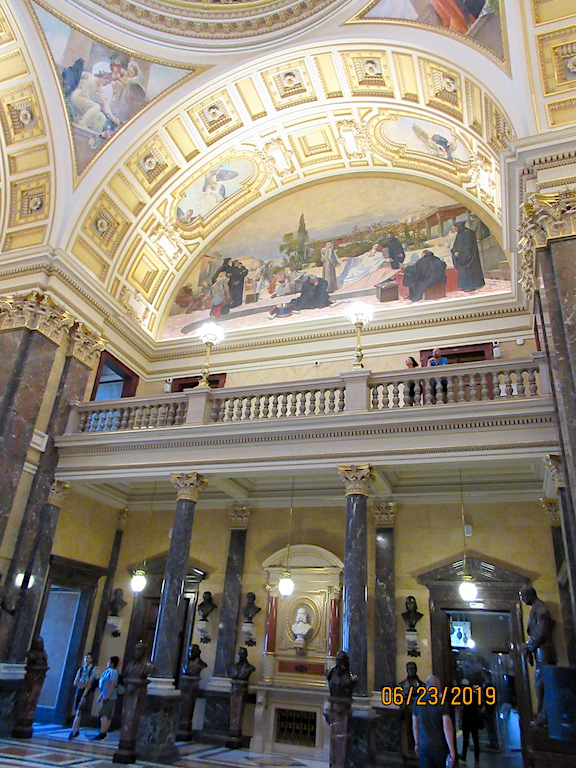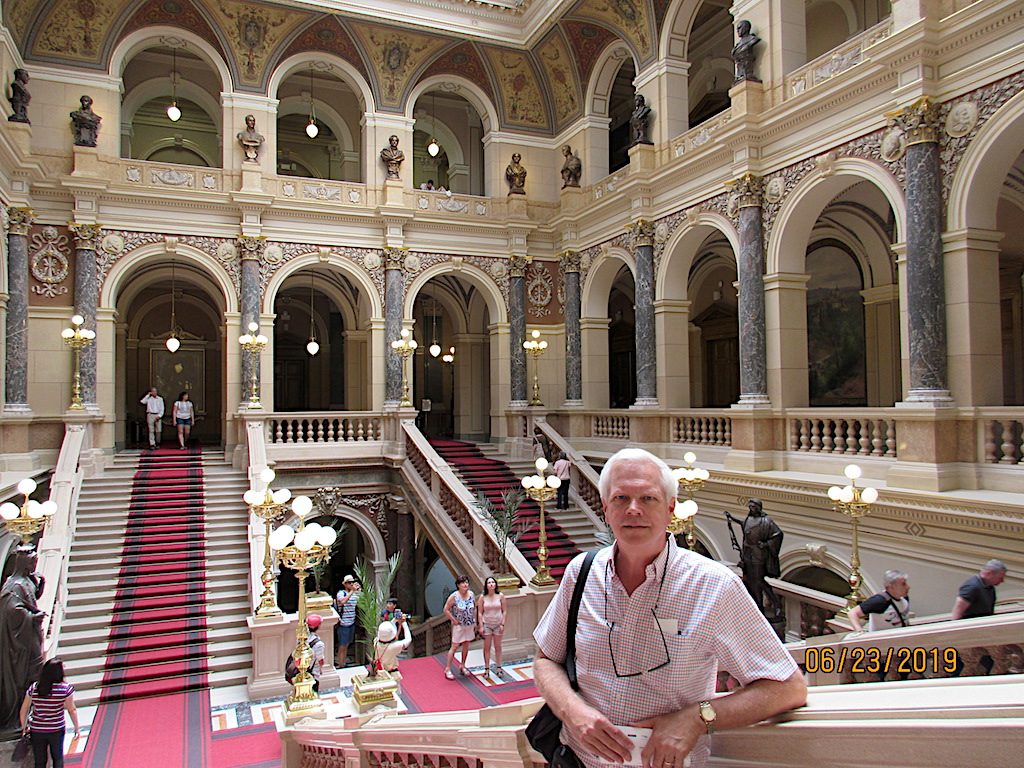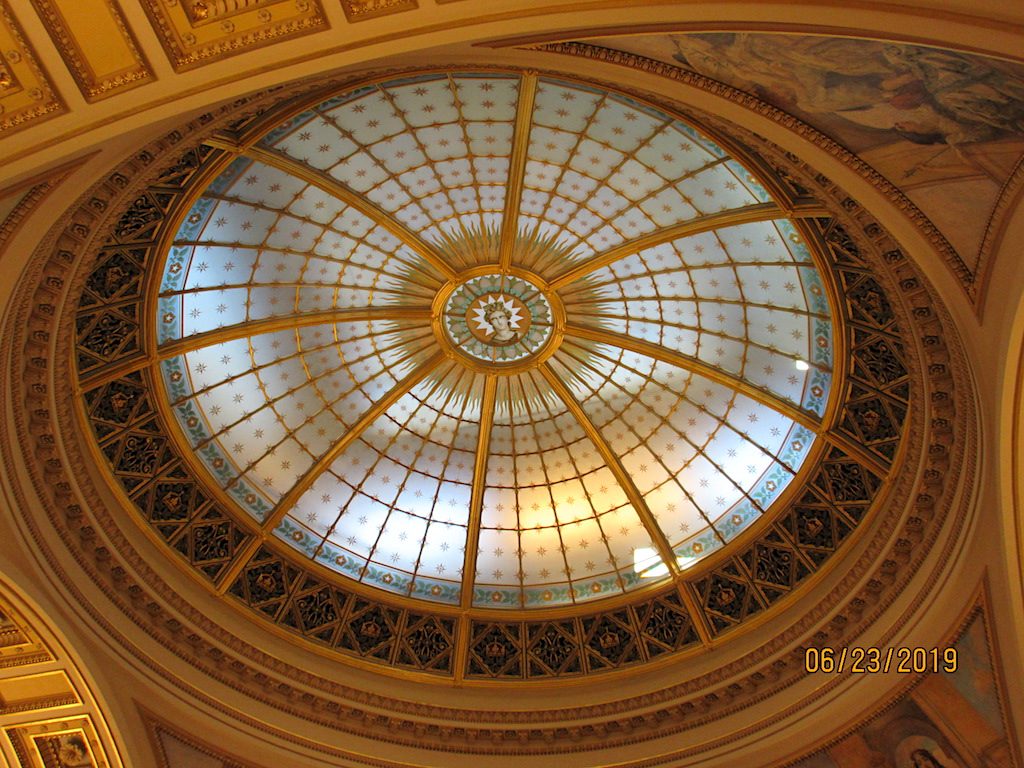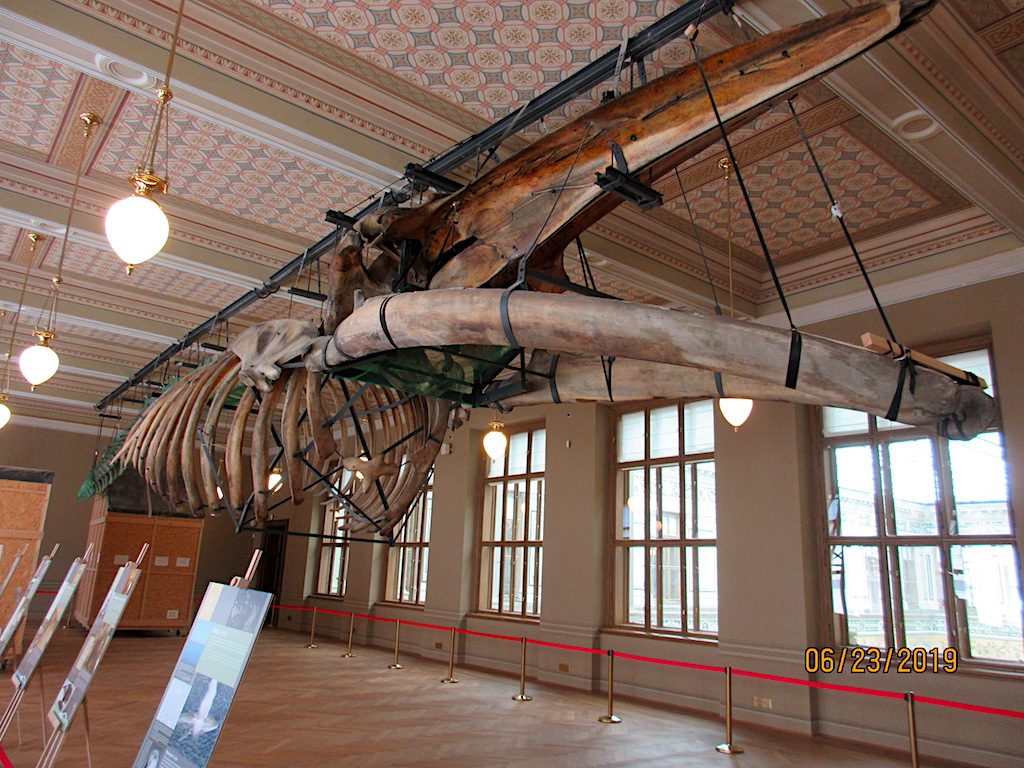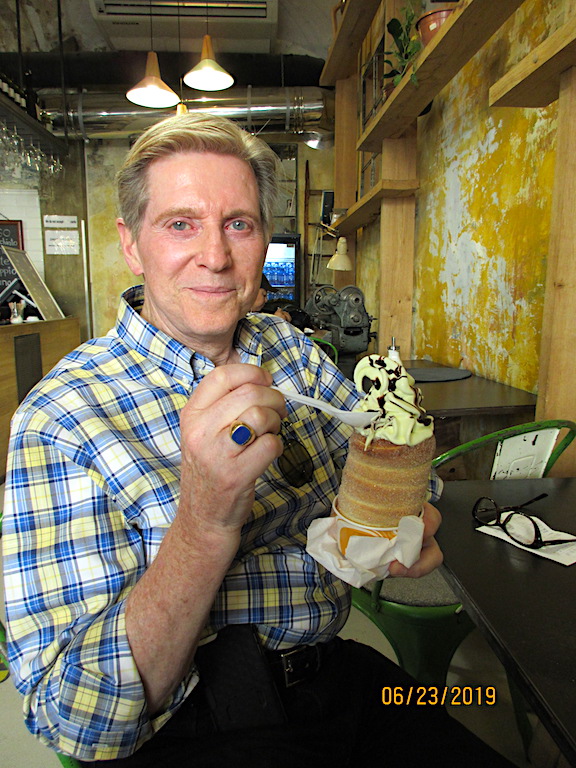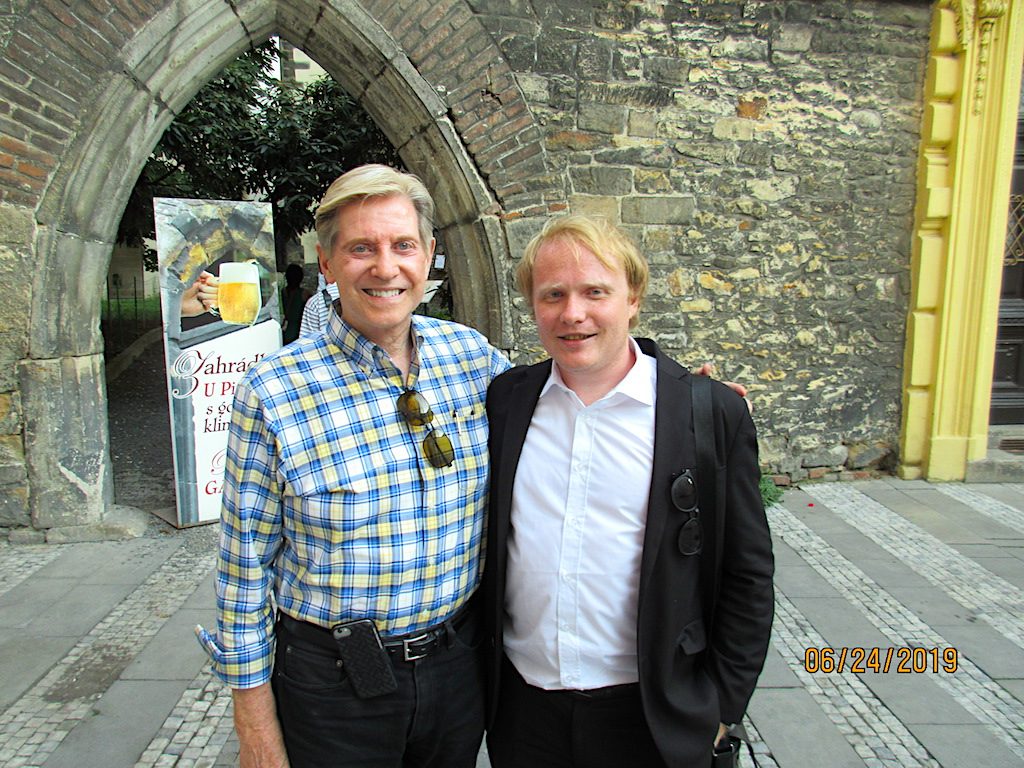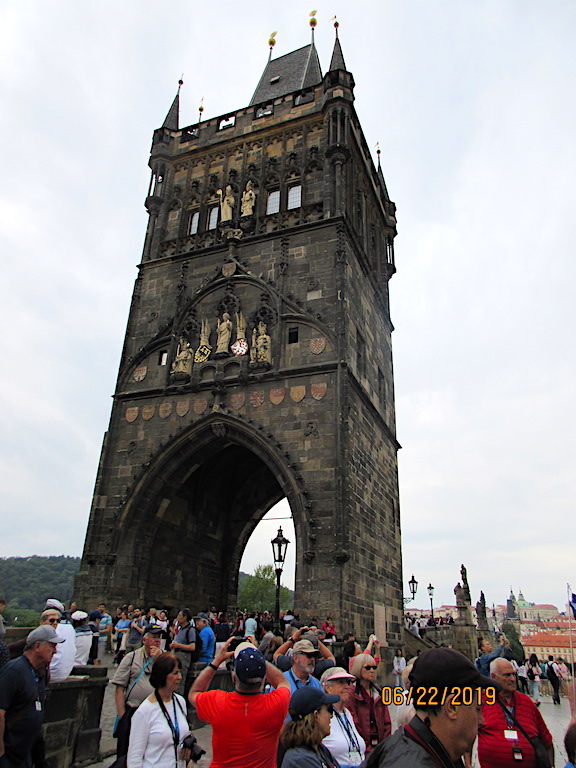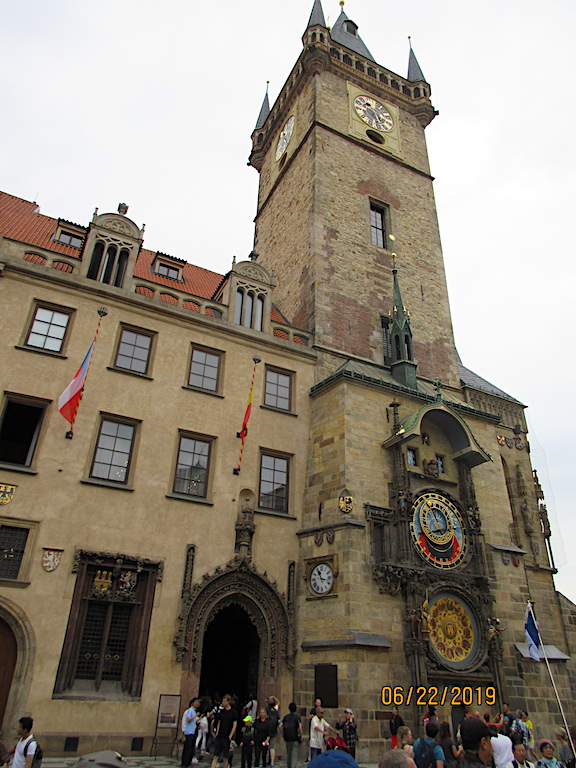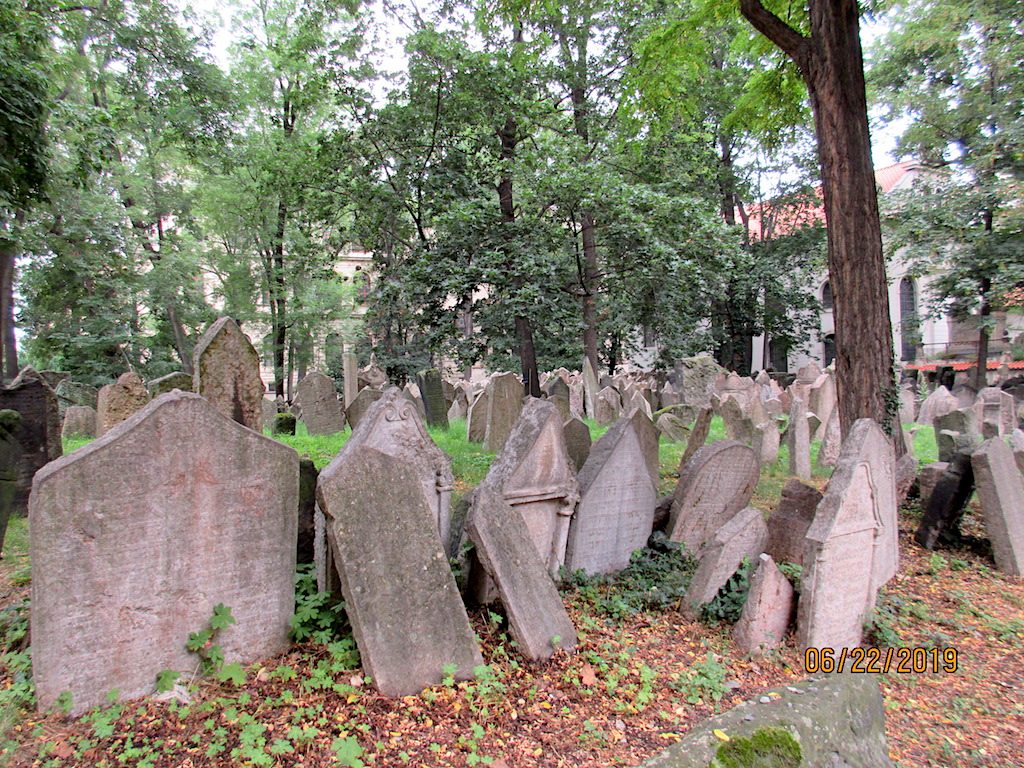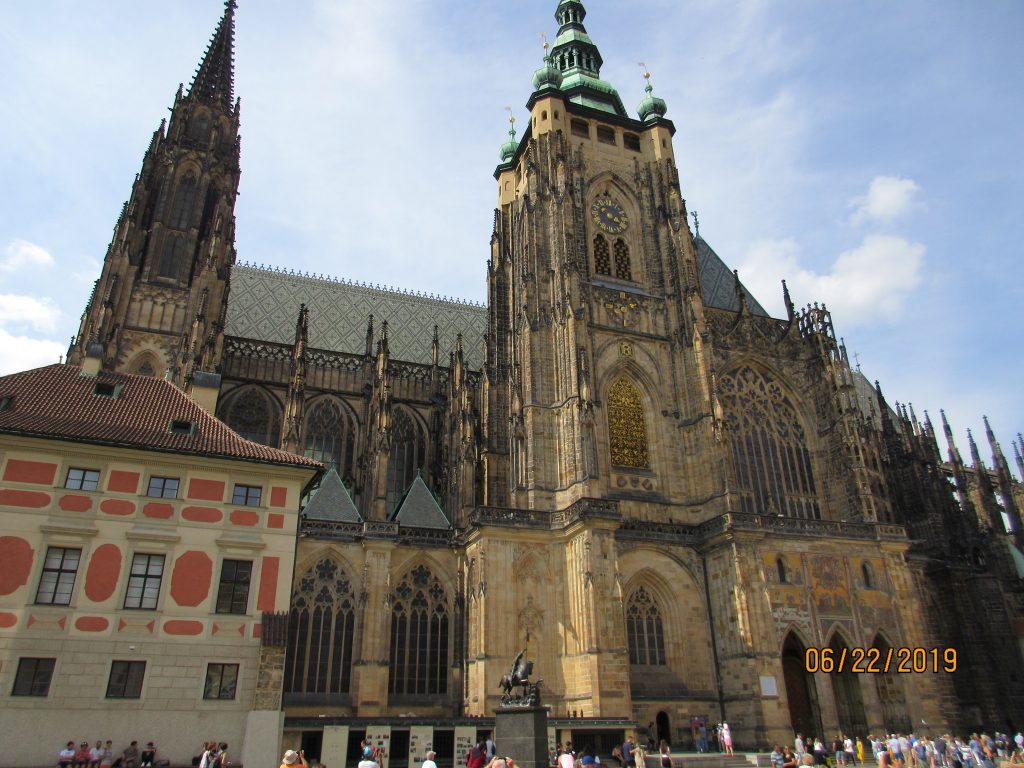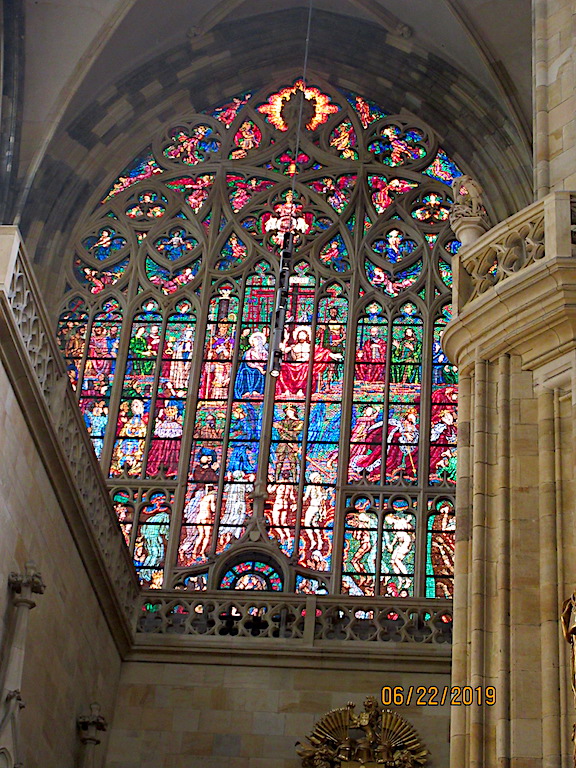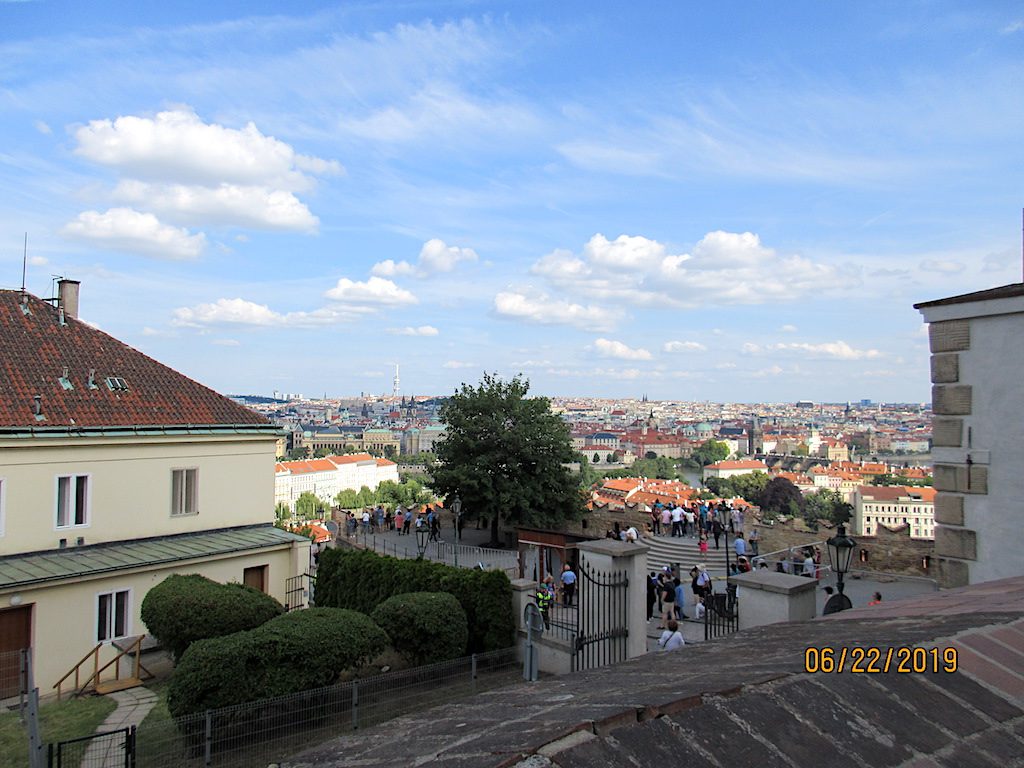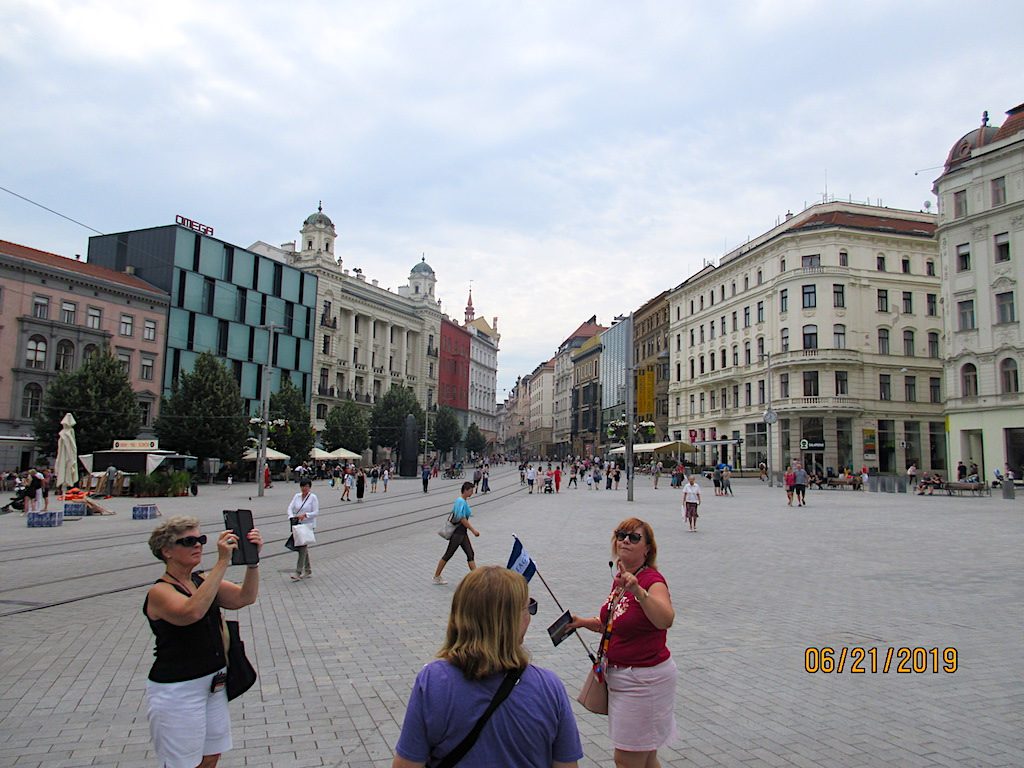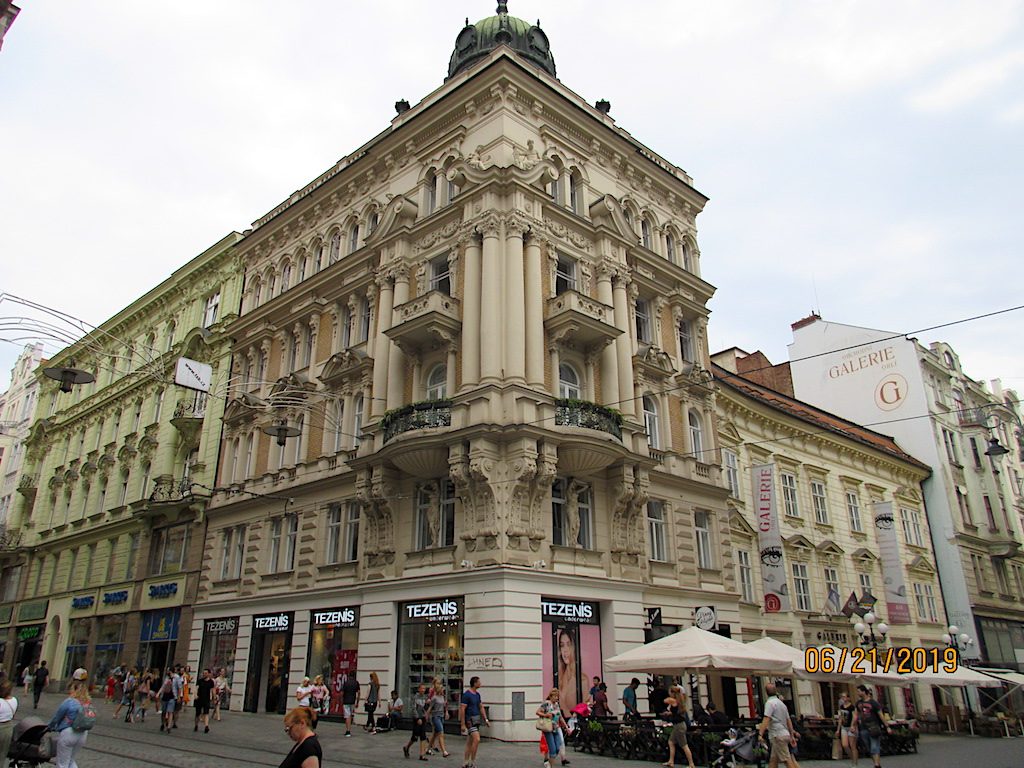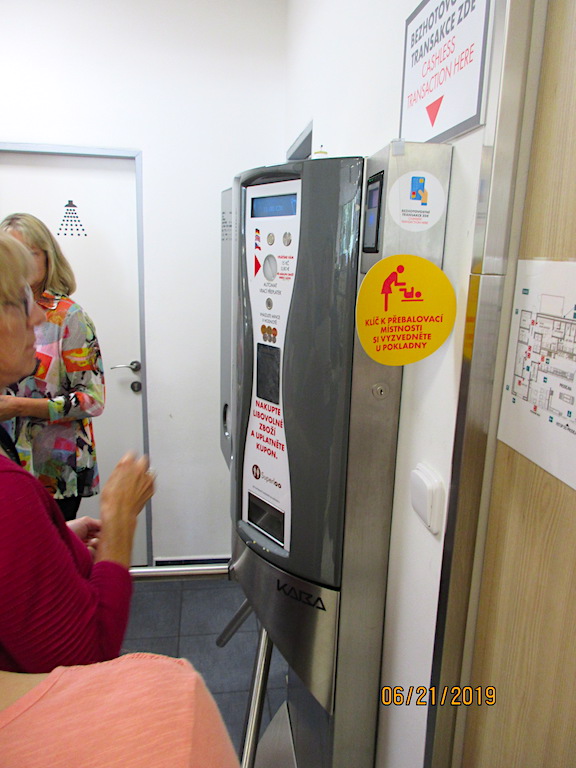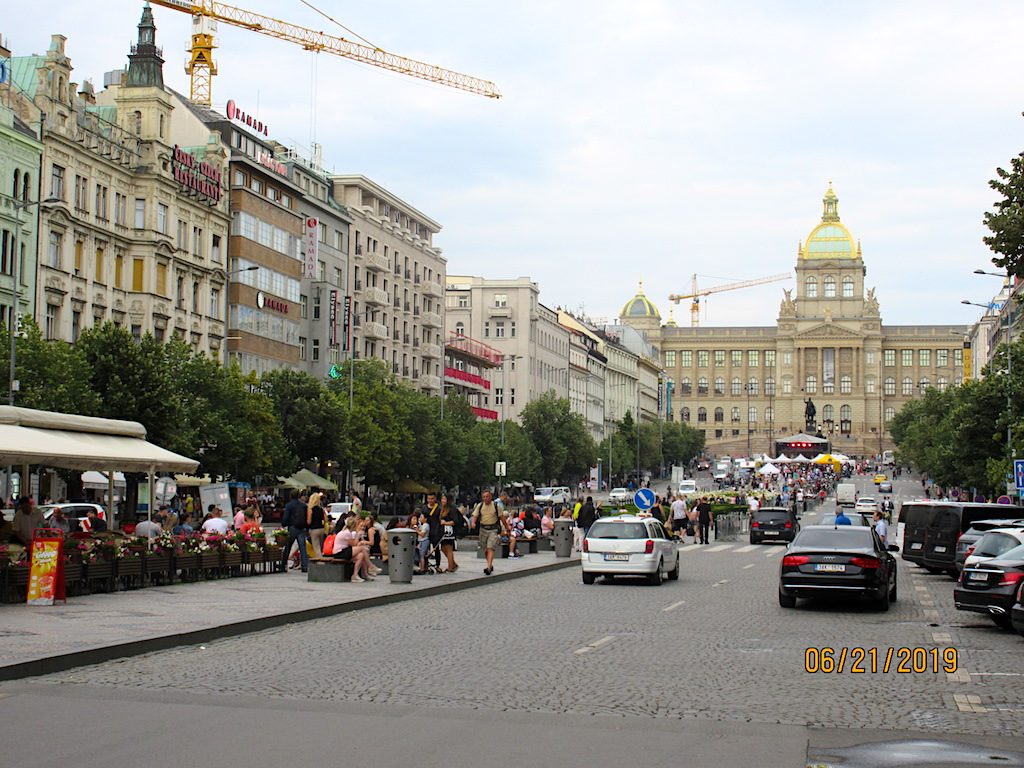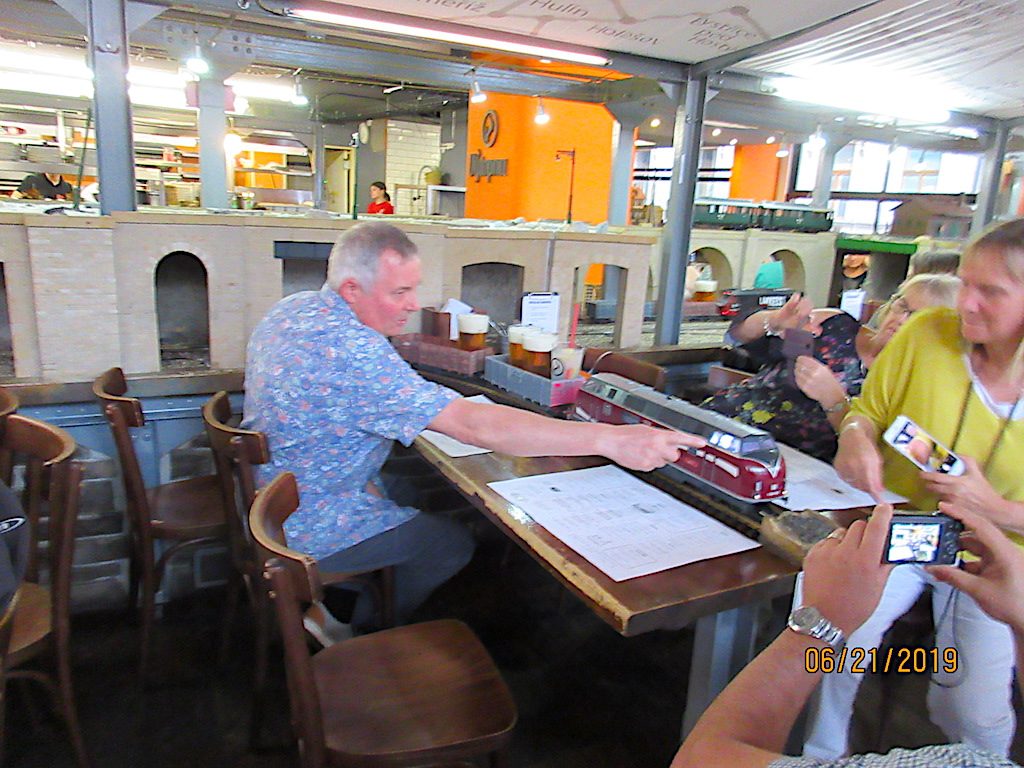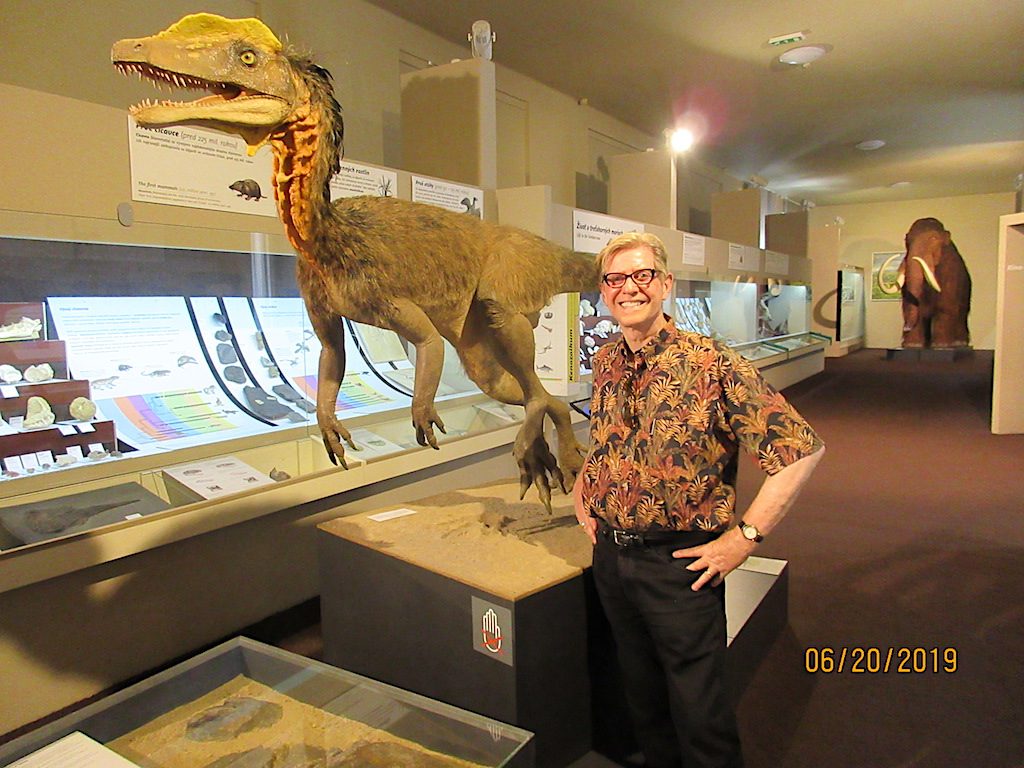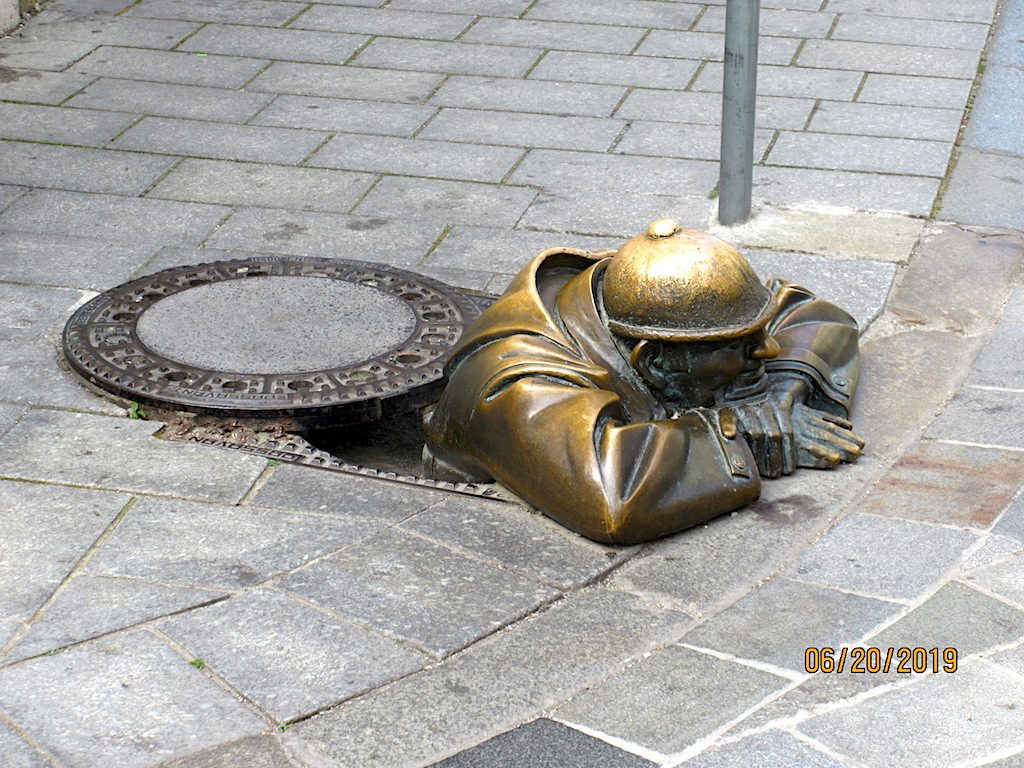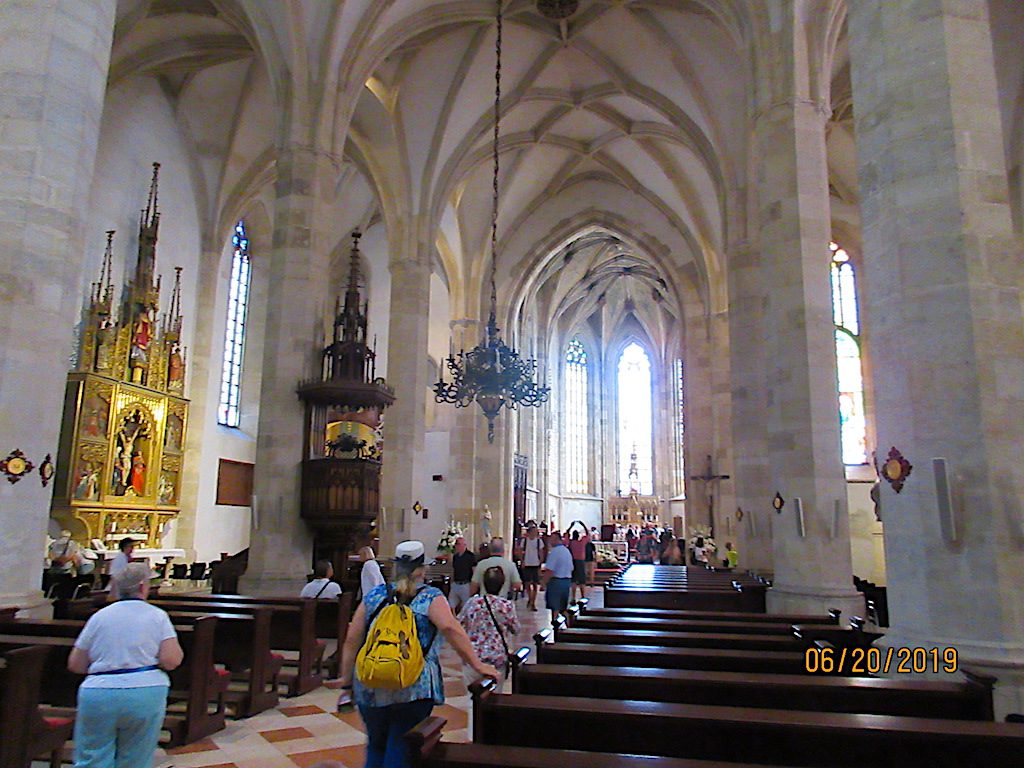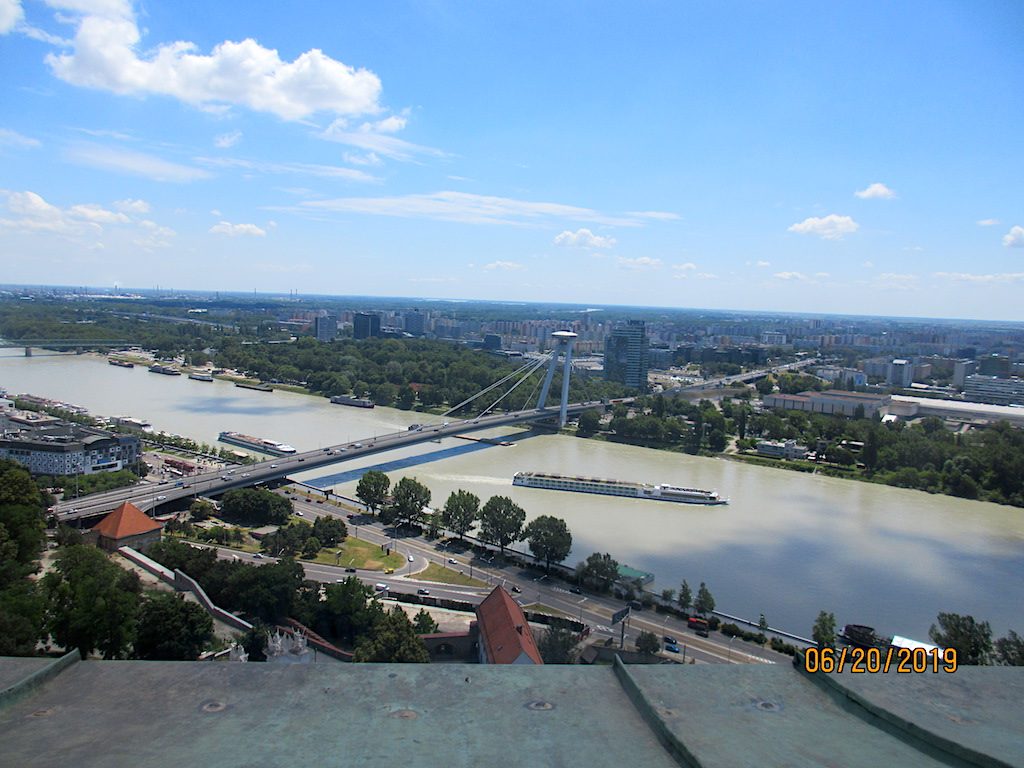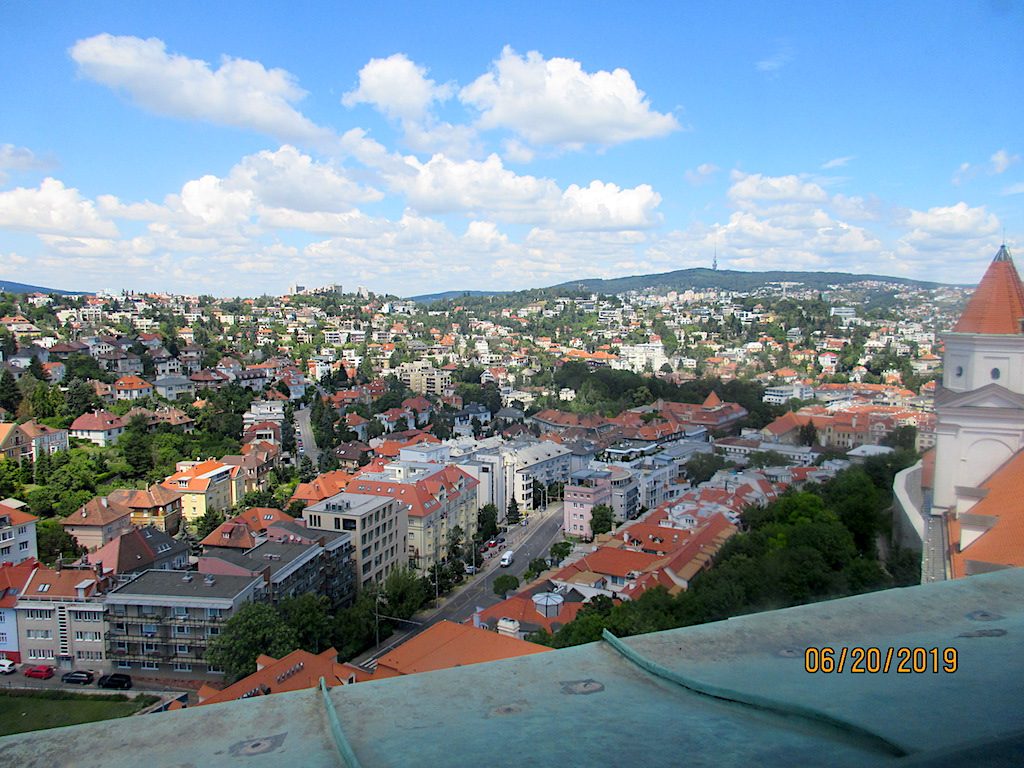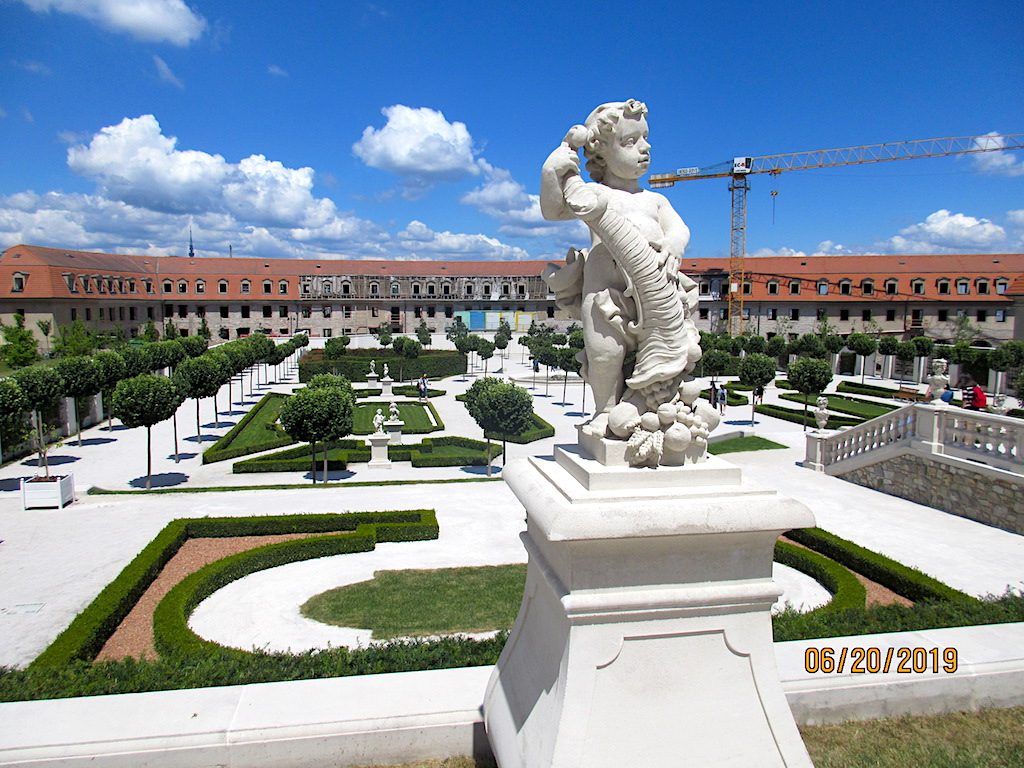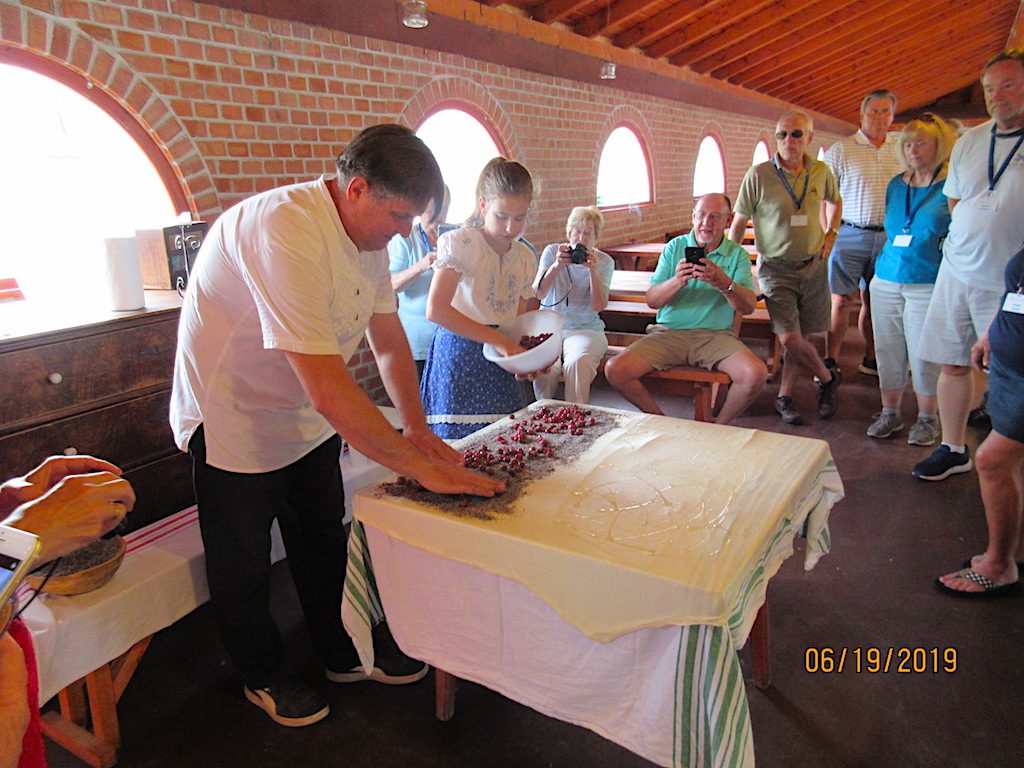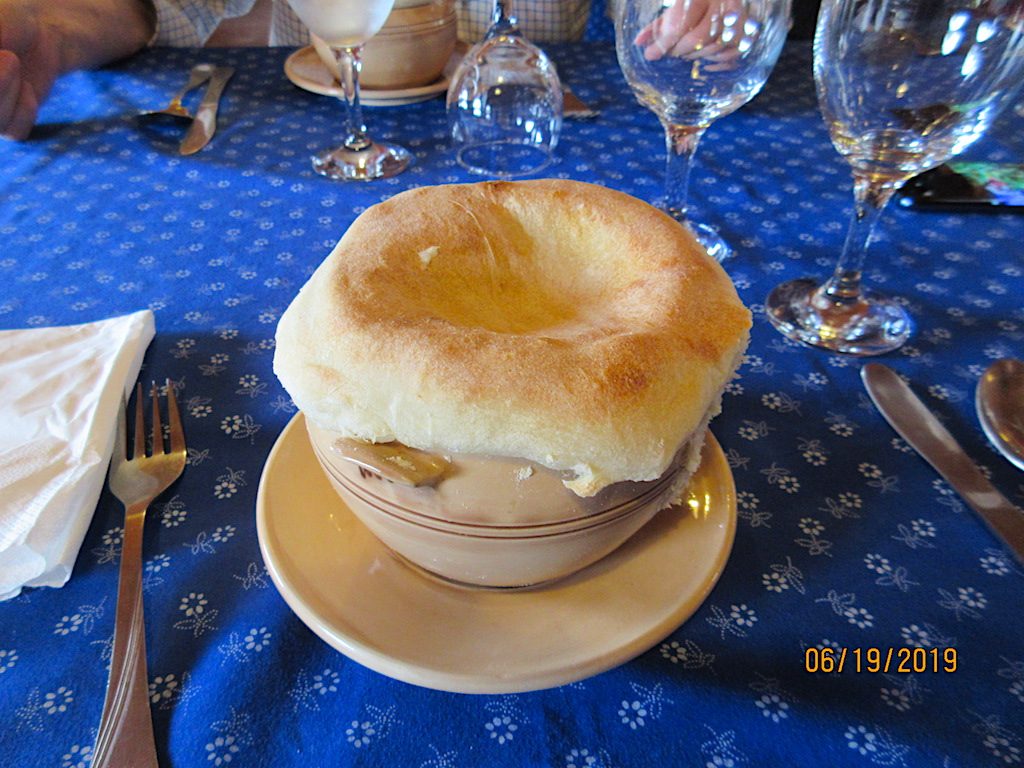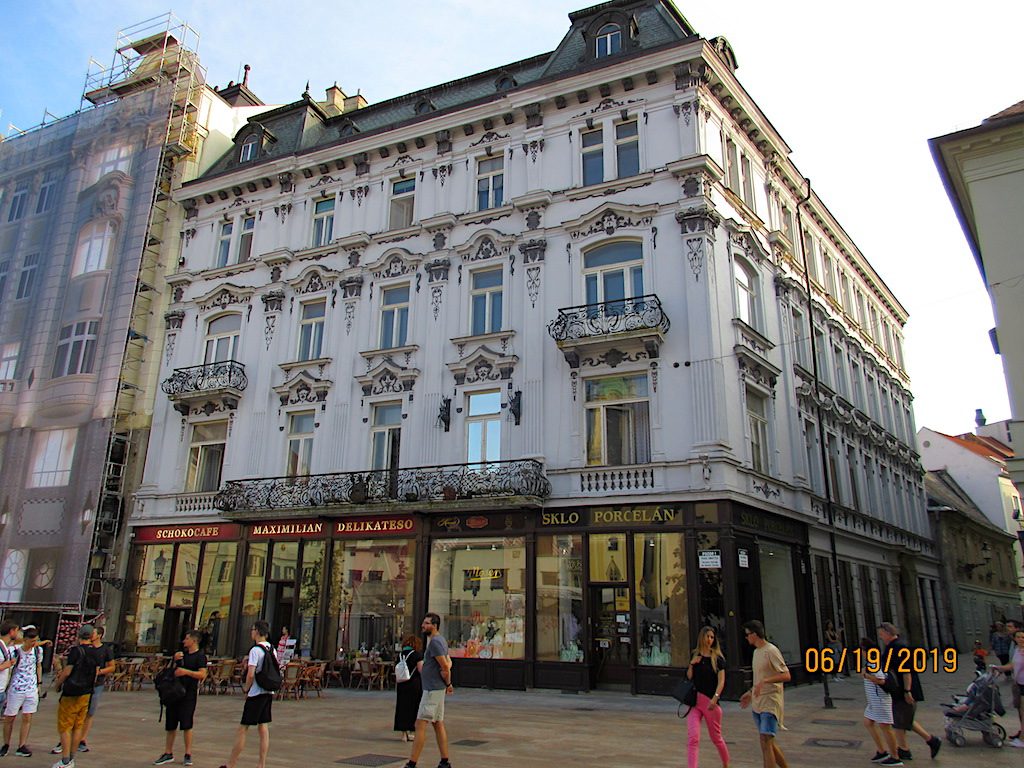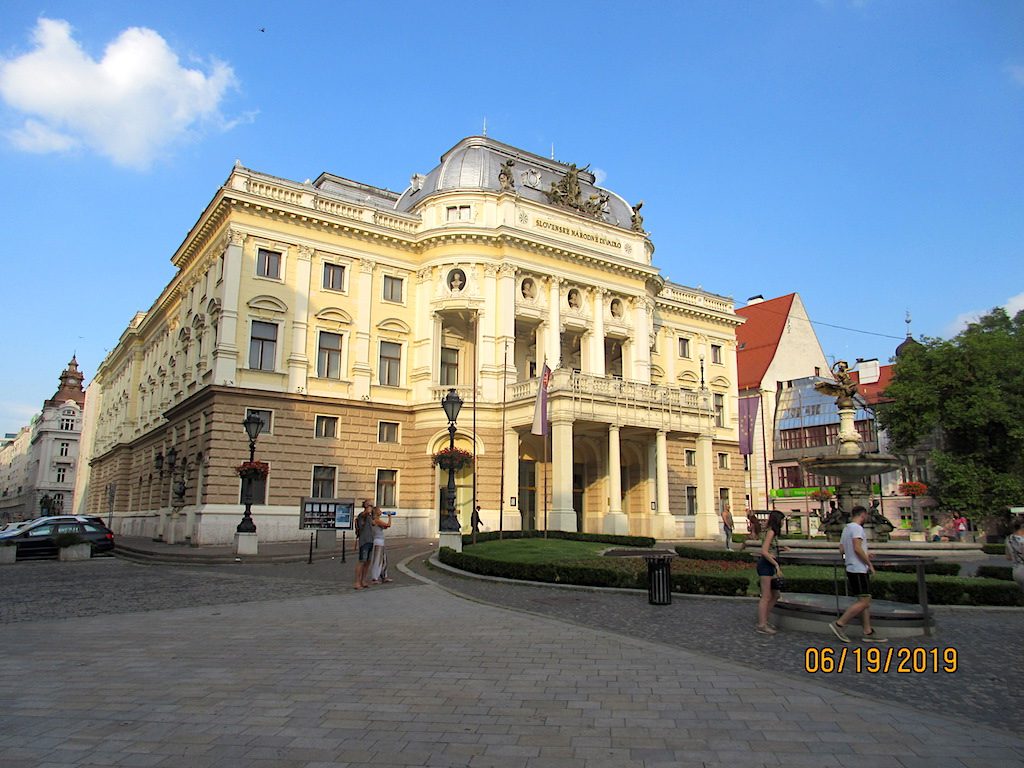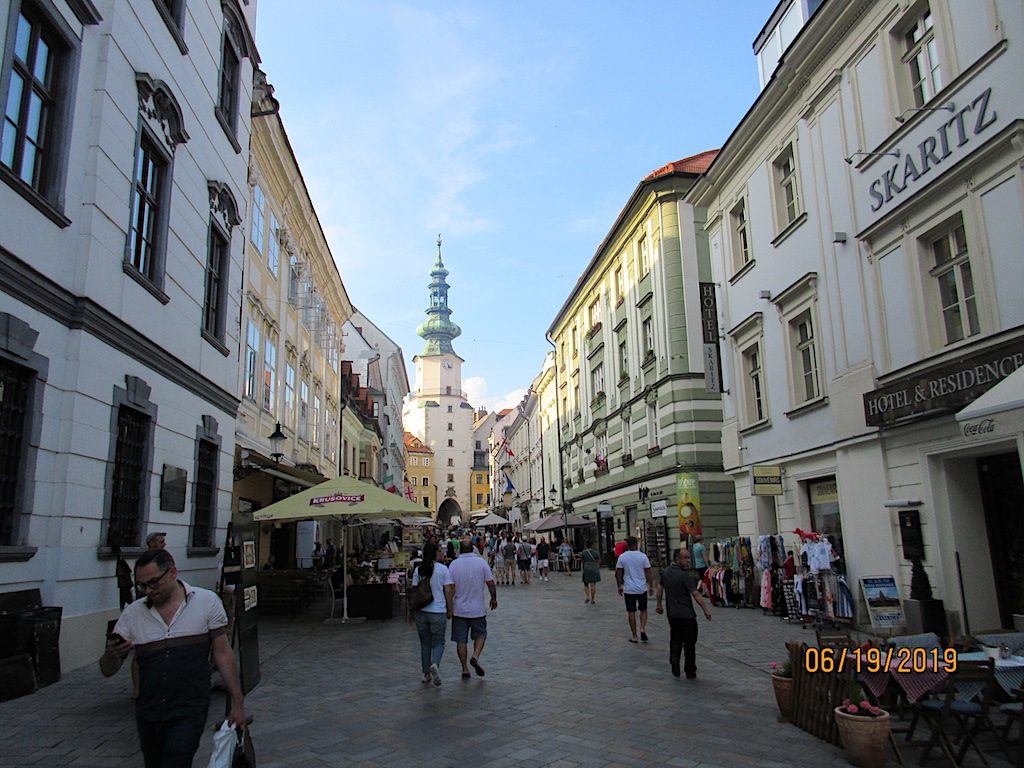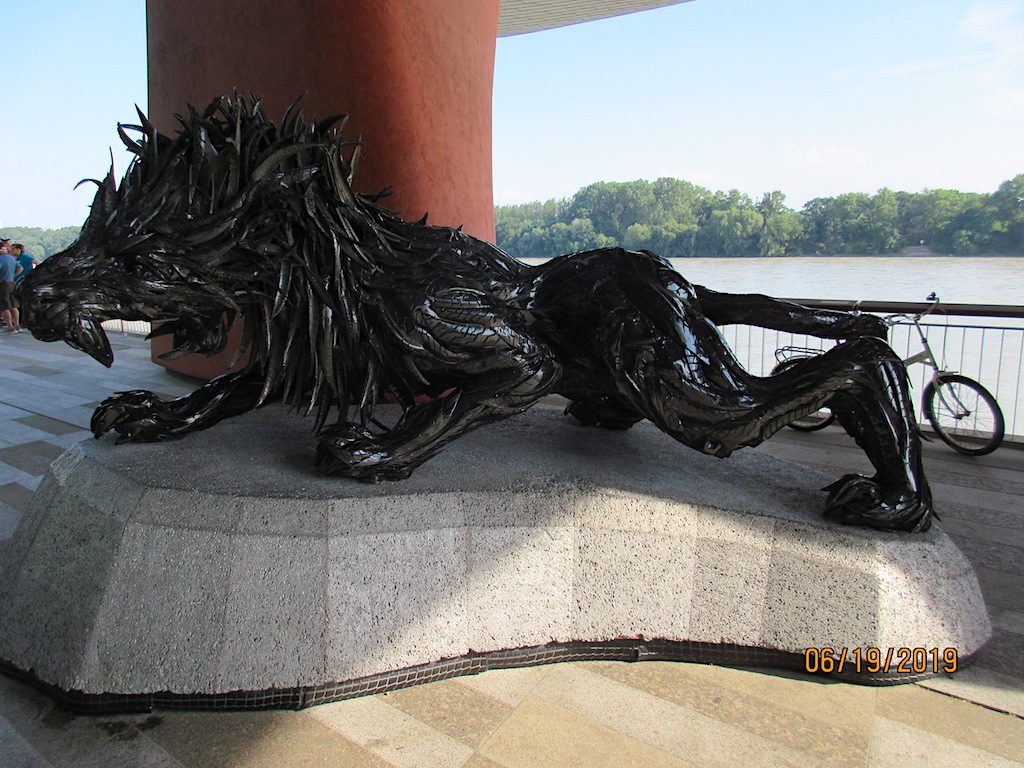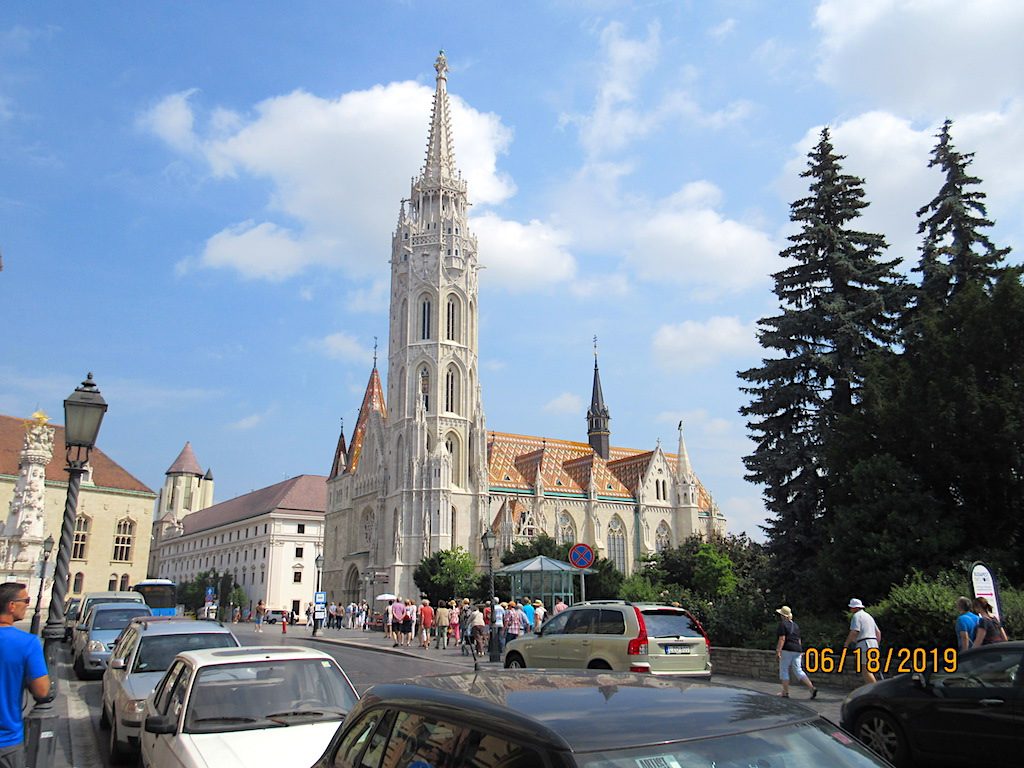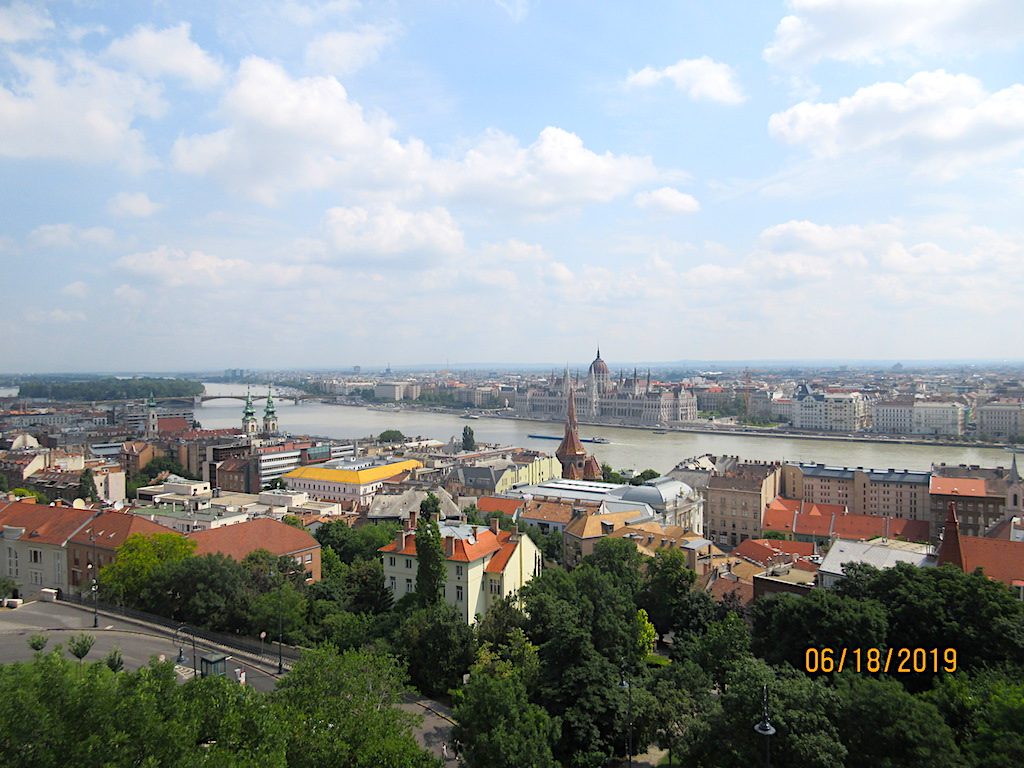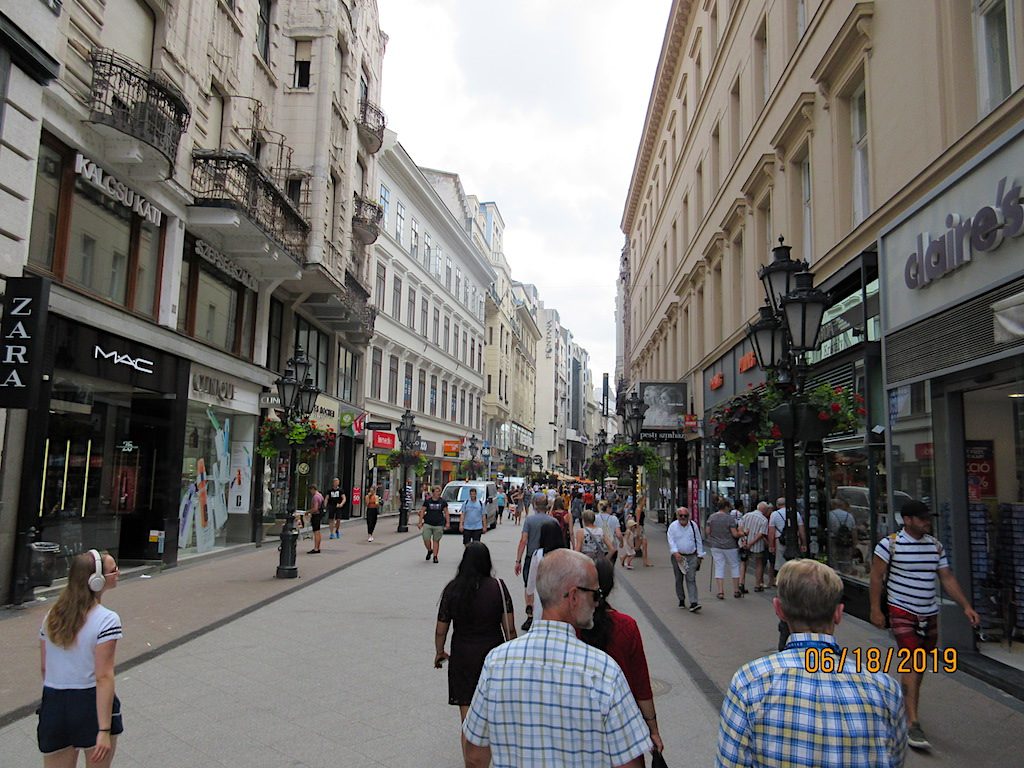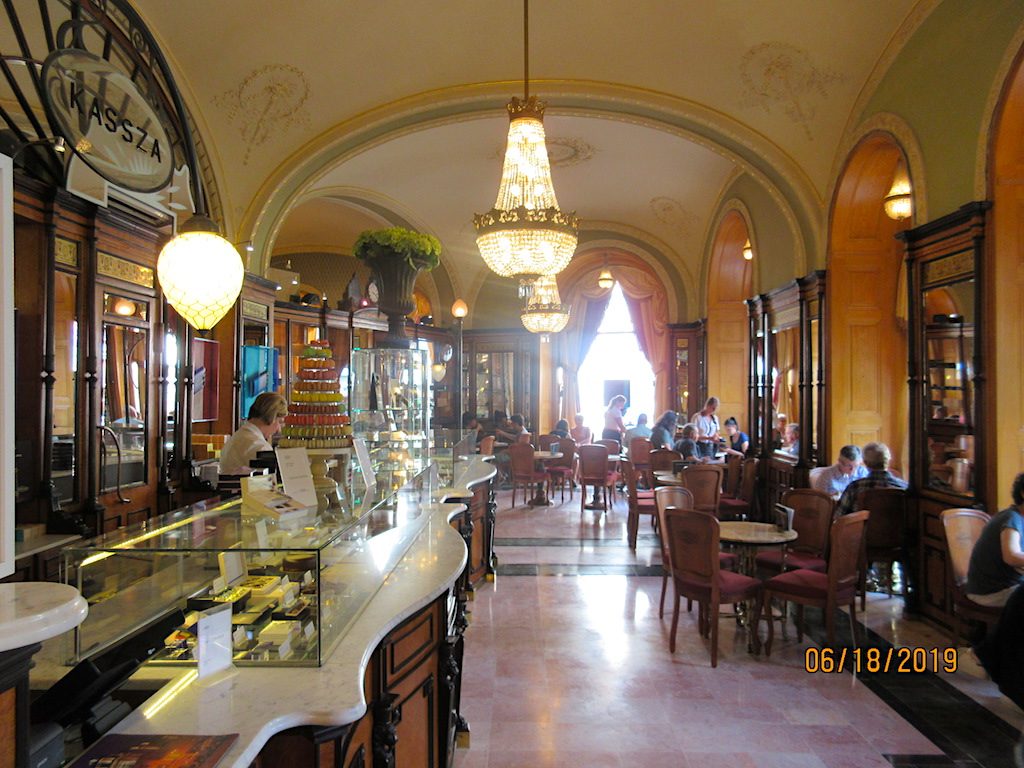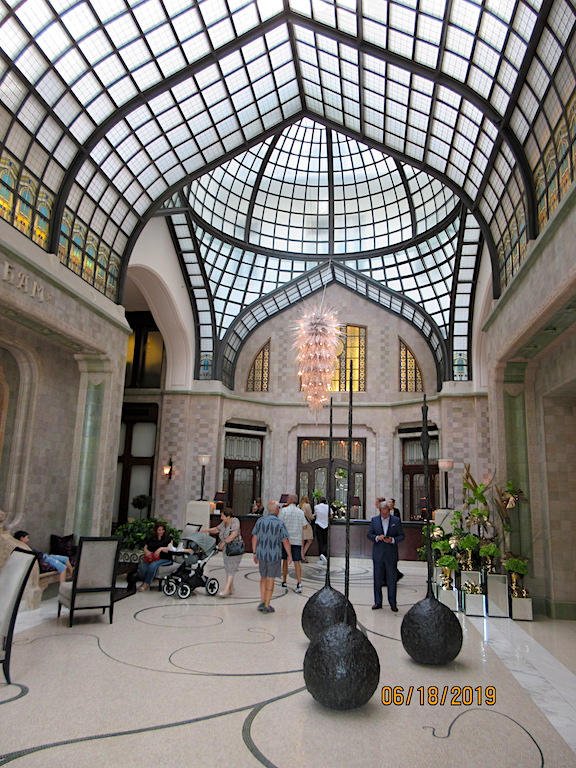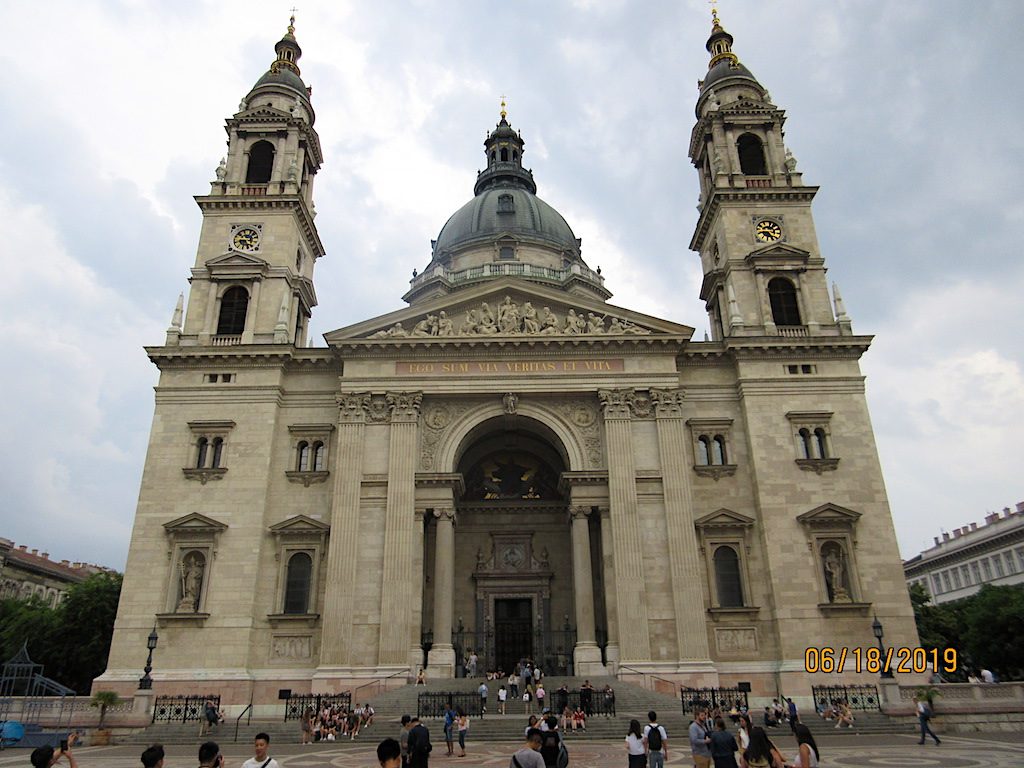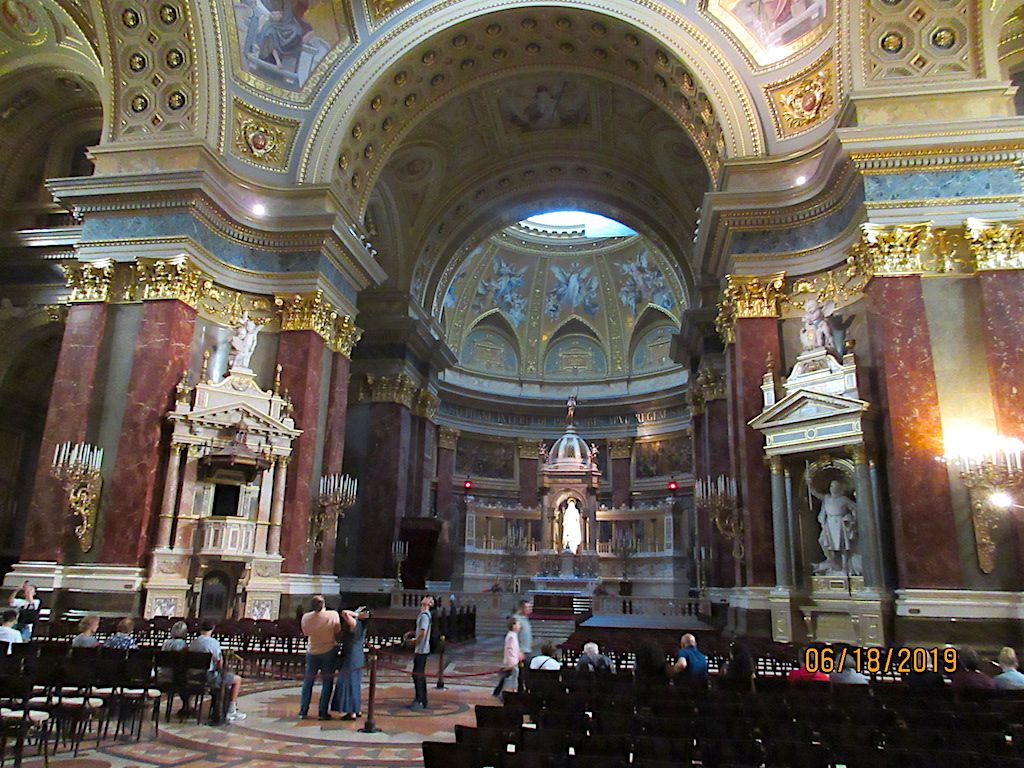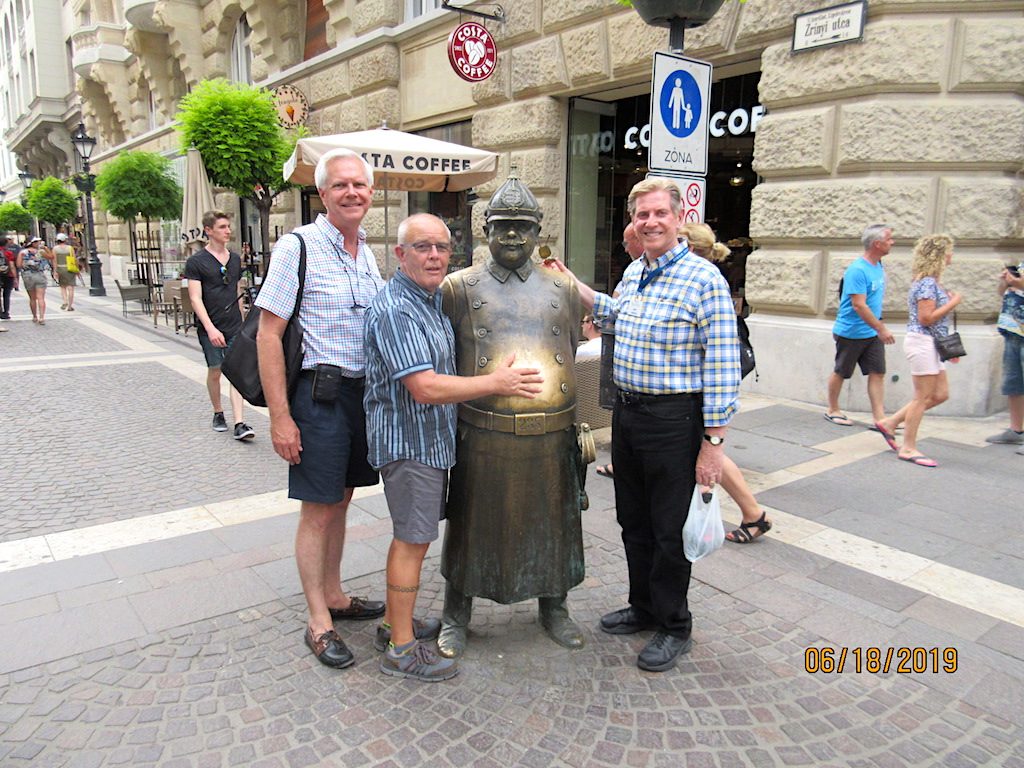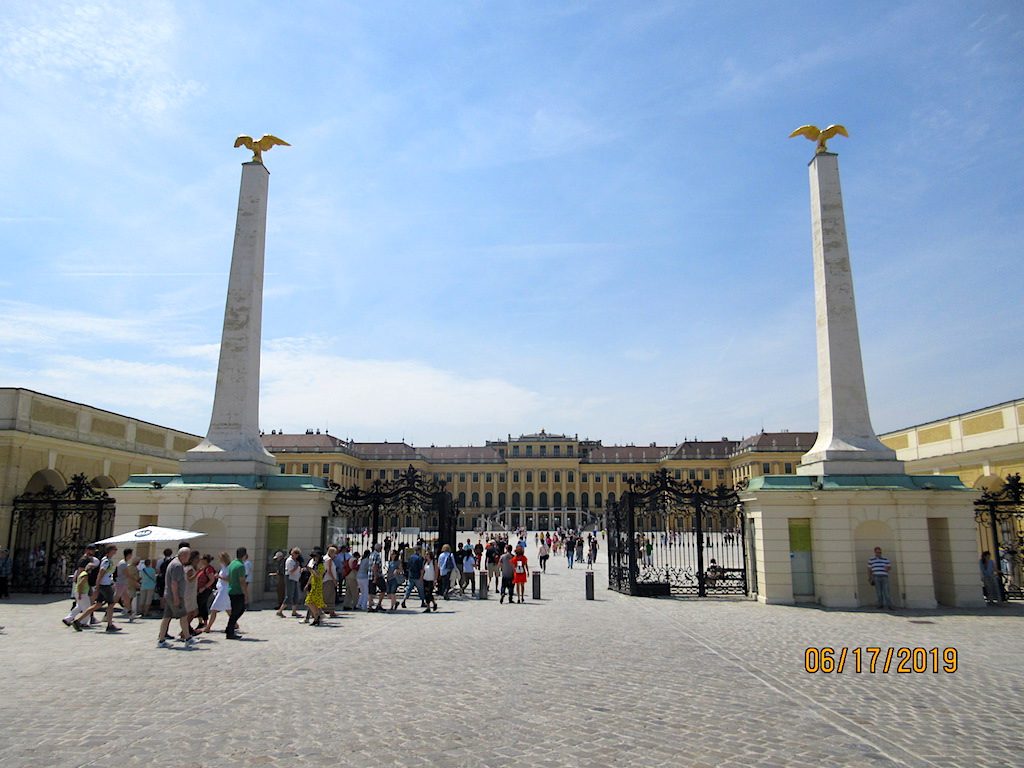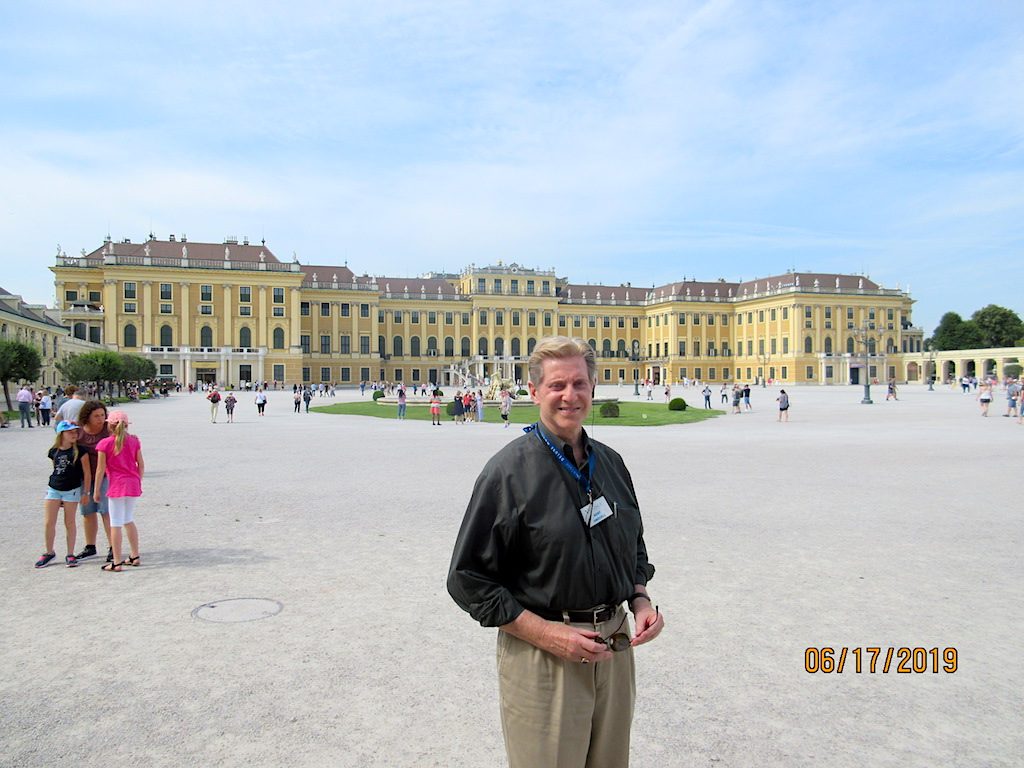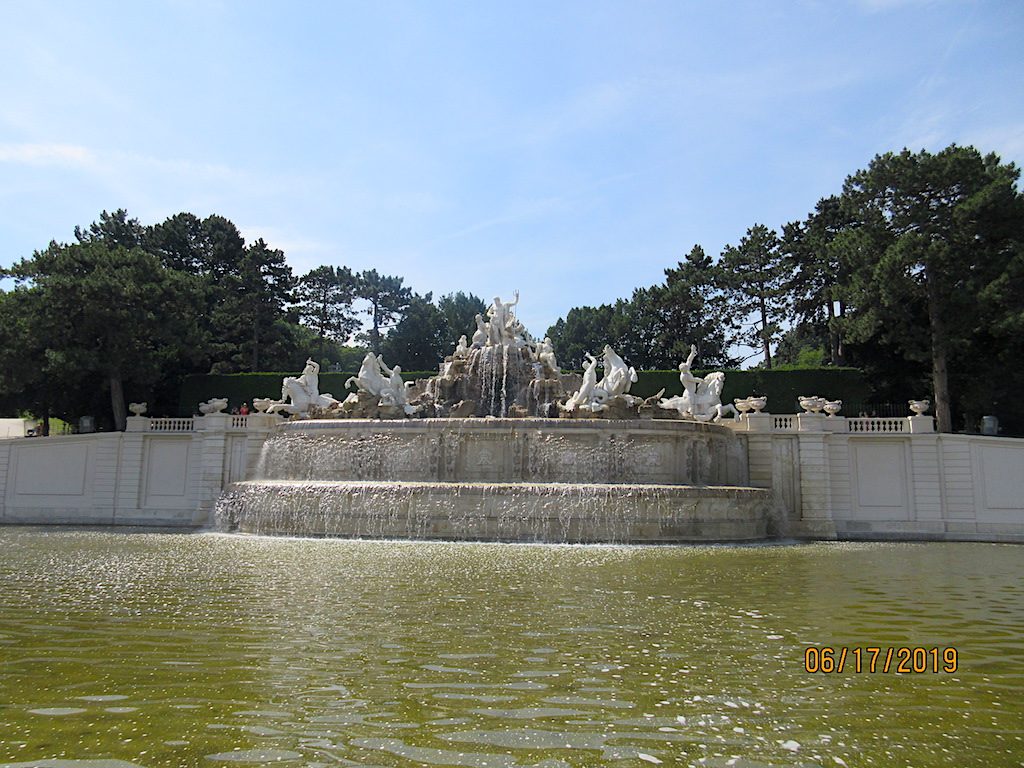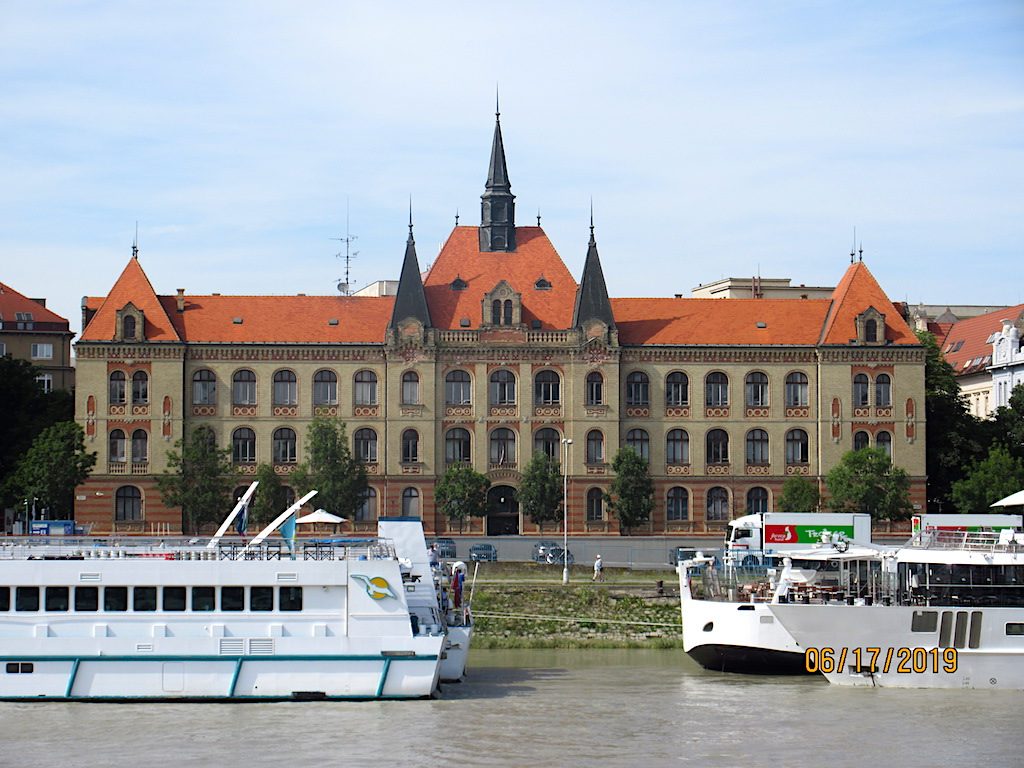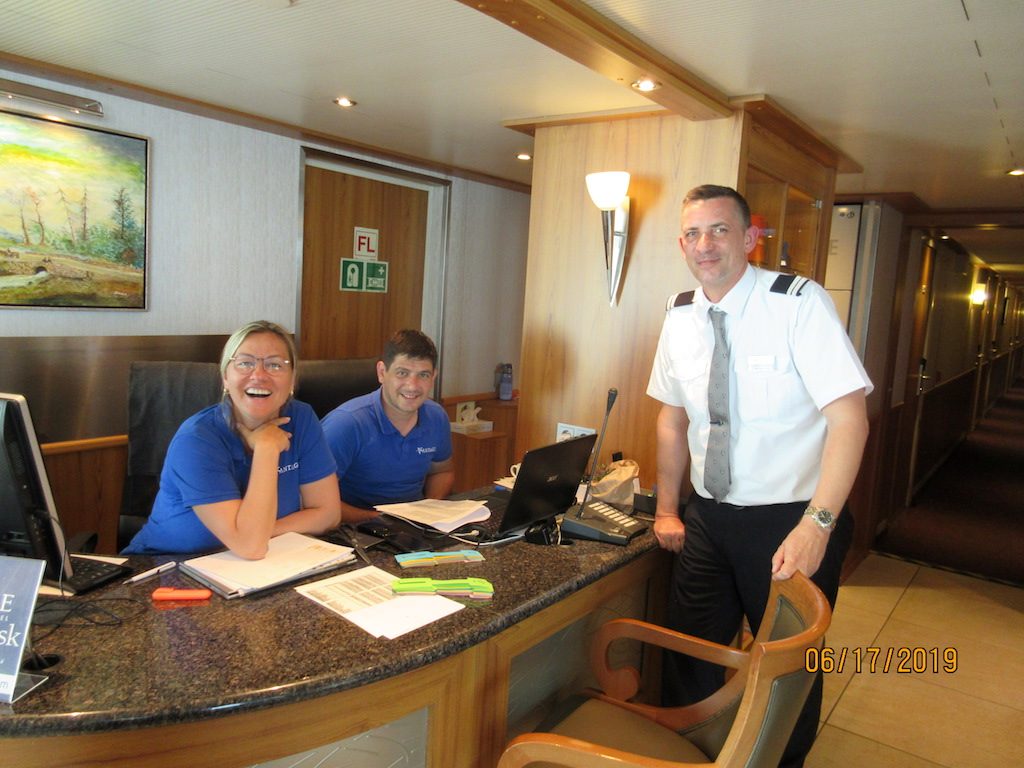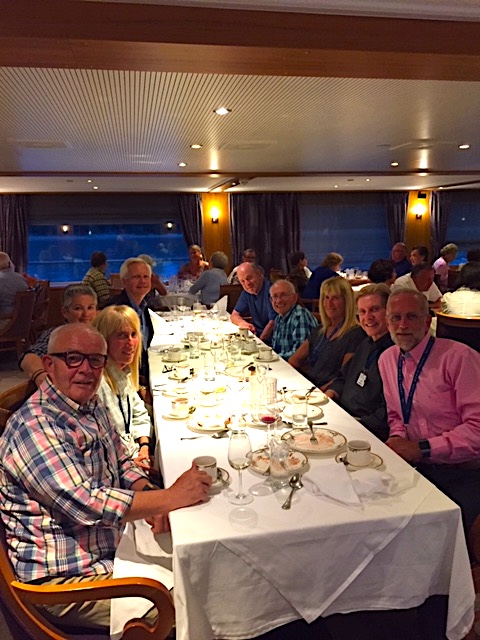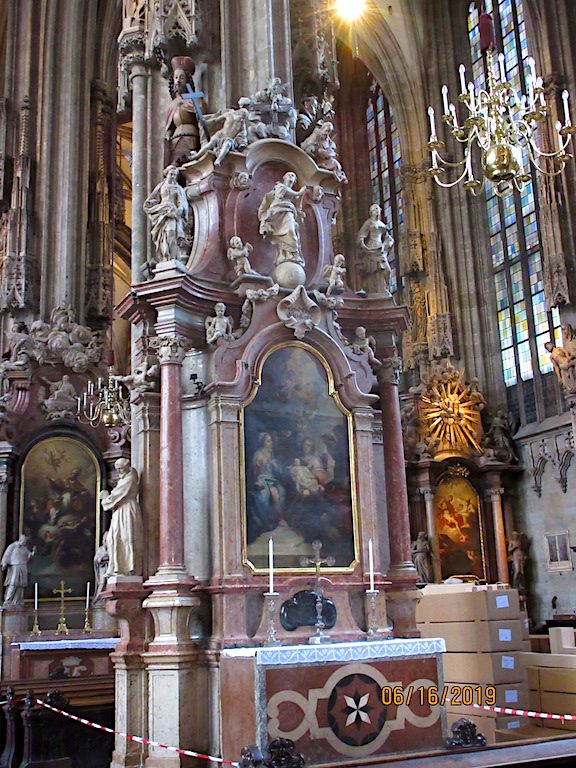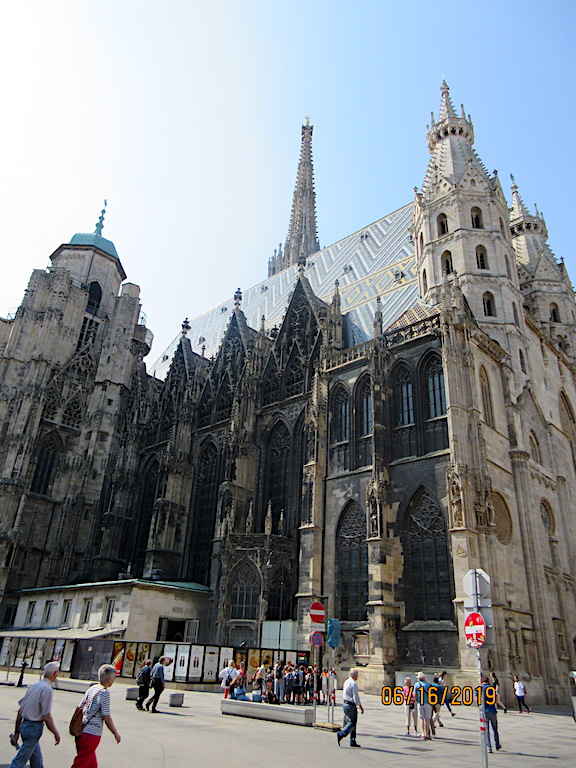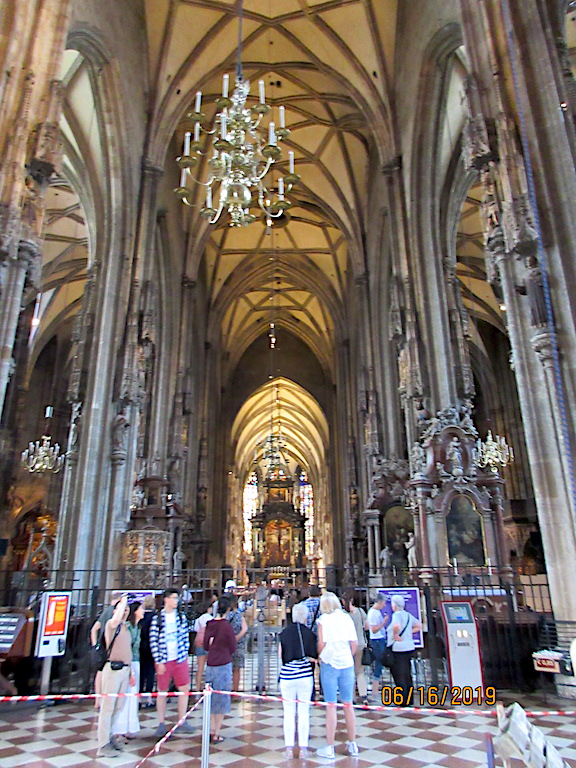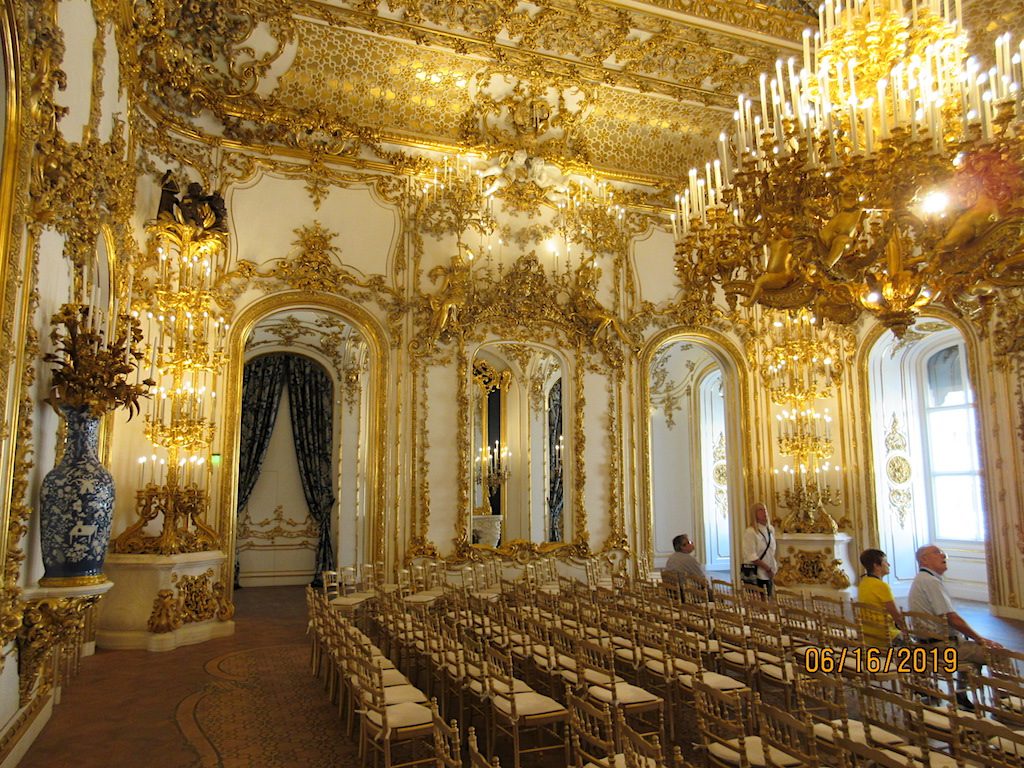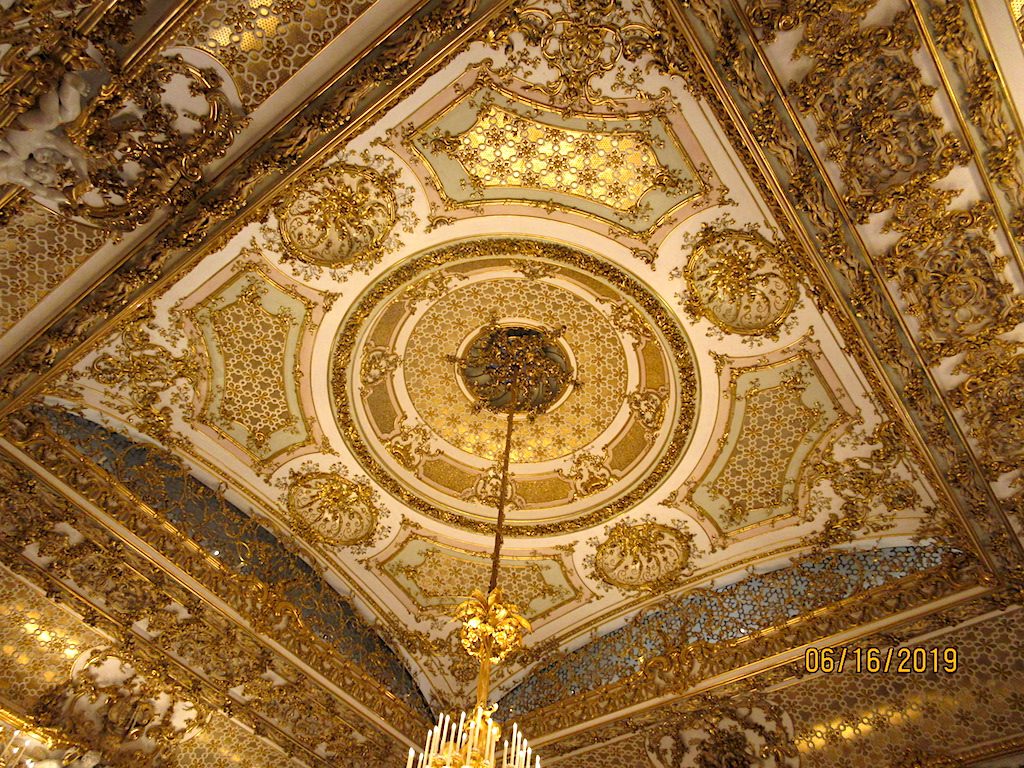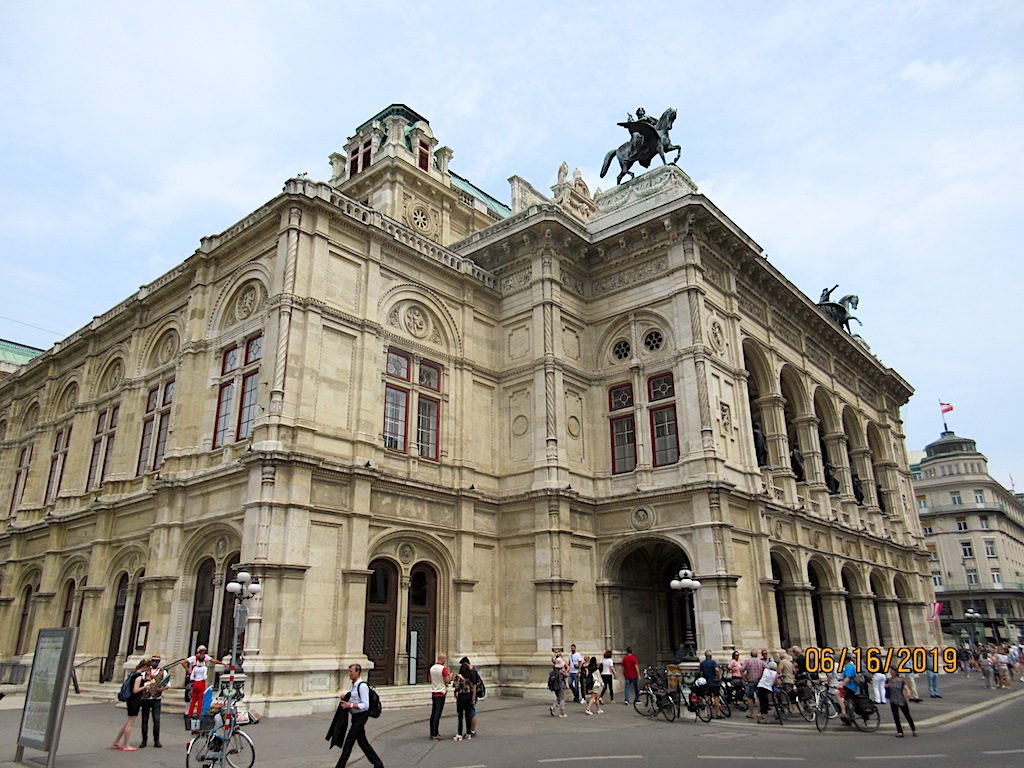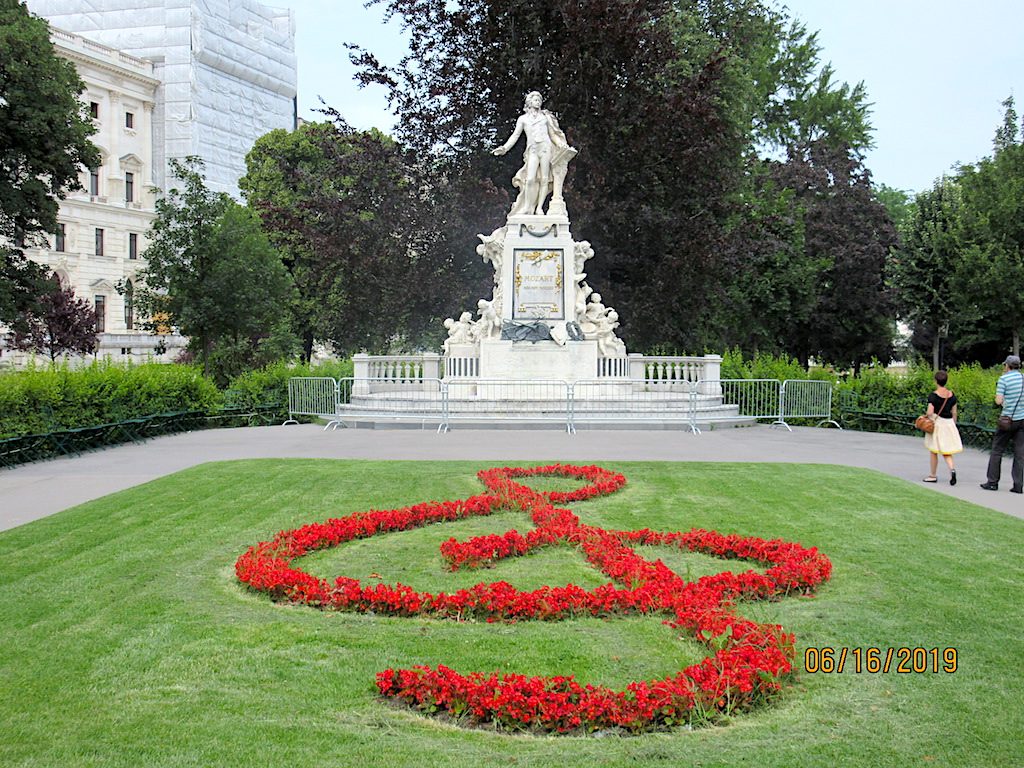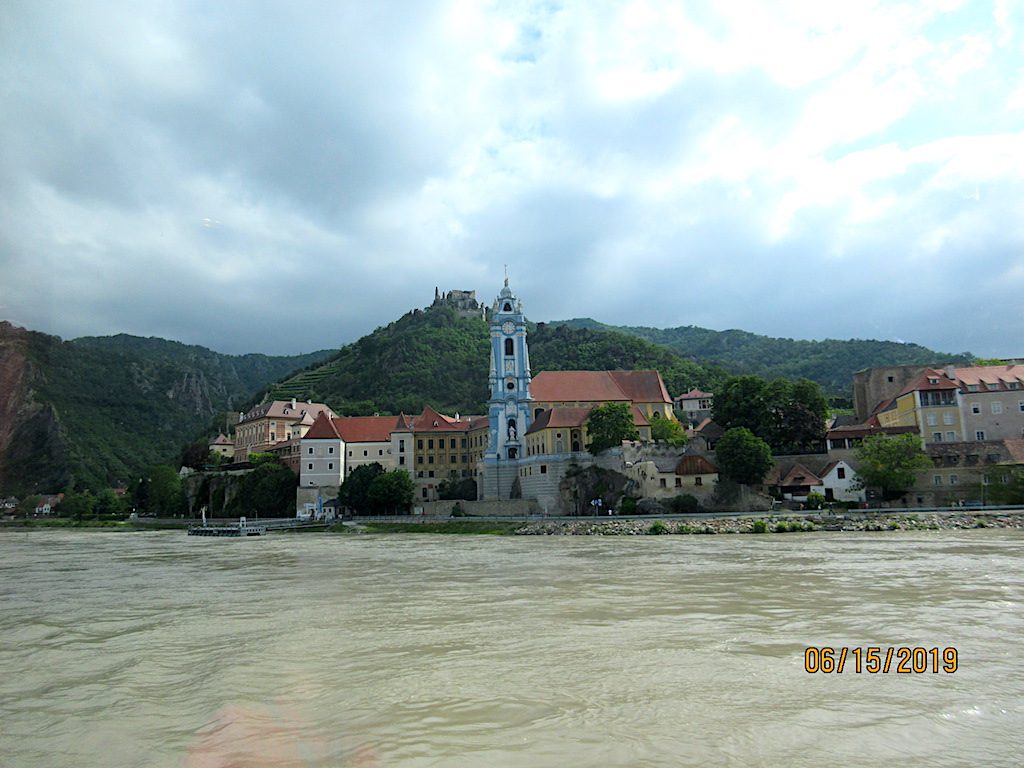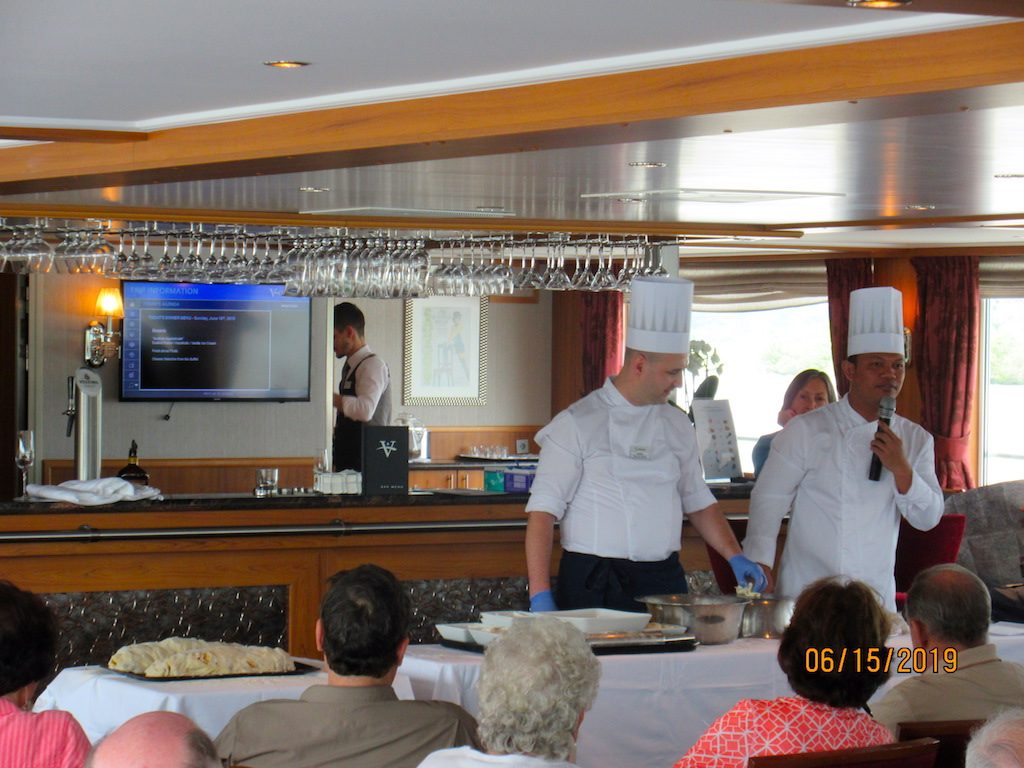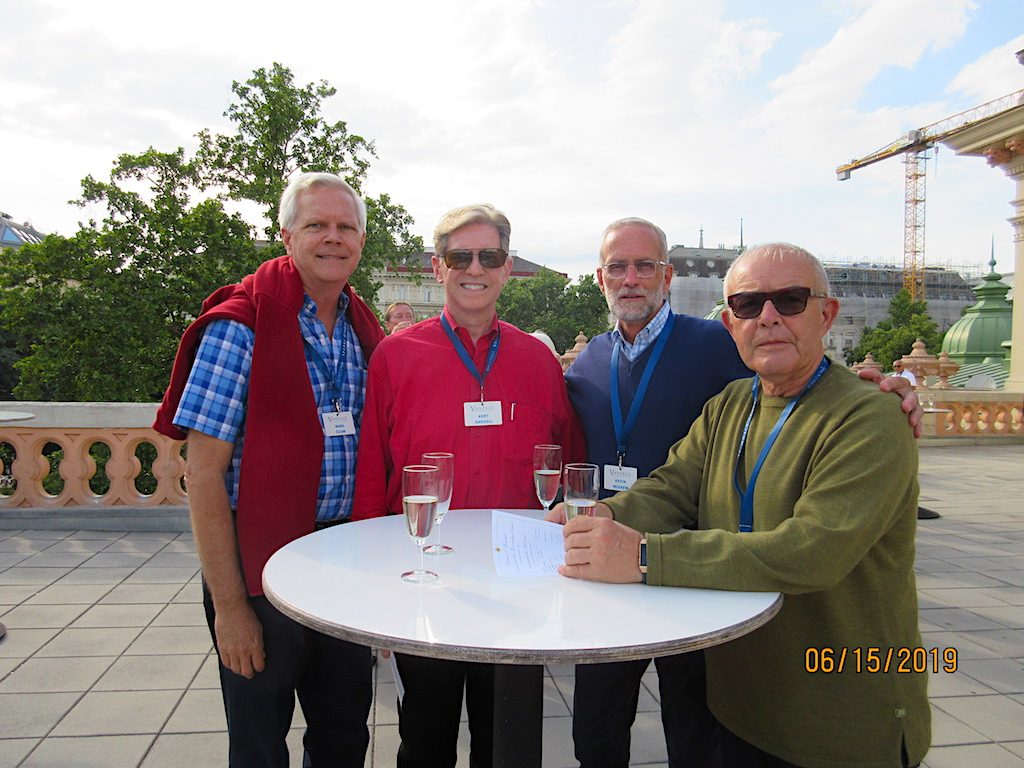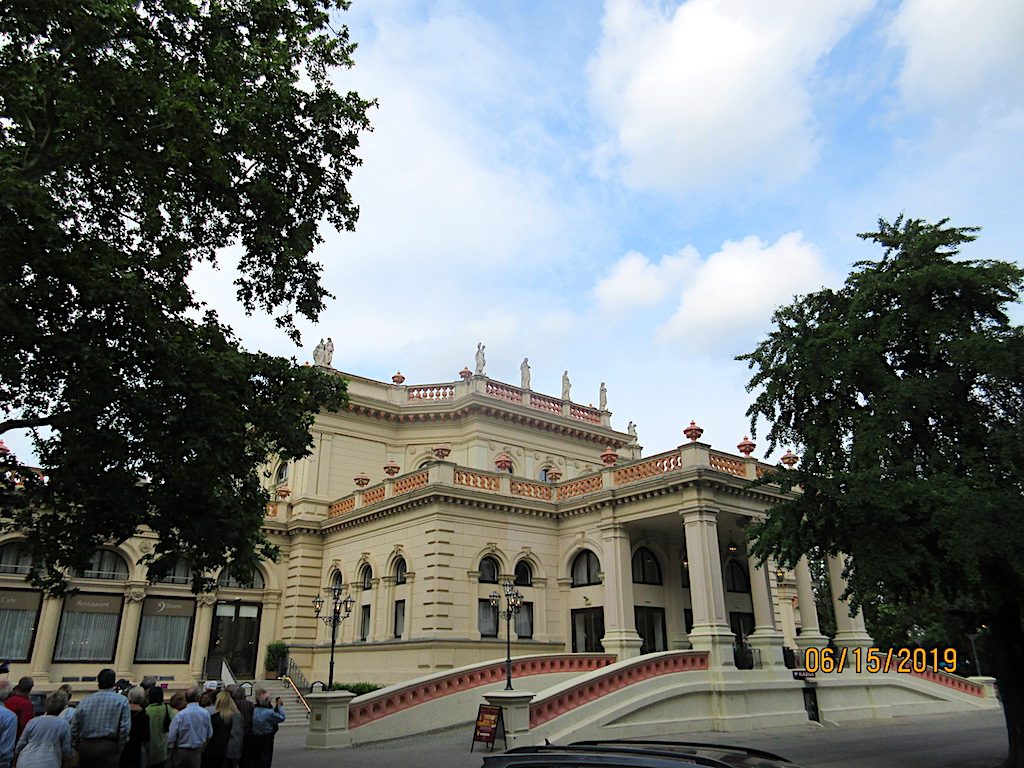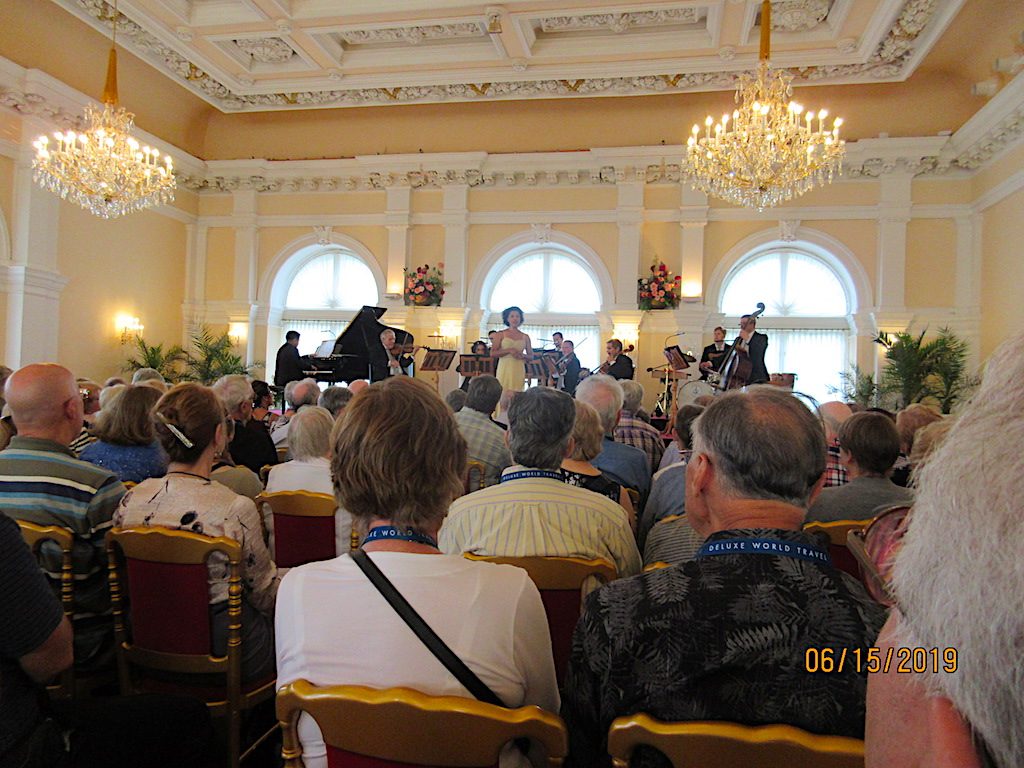Our flight home departed about 10:00am bound for Newark, New Jersey arriving about 12:30pm local time. When we arrived in Newark we learned that our flight to San Diego had been delayed due to high winds and bad weather in the area. We ended up spending about seven hours in the airport before our flight for San Diego took off. The flight home was another six hours in the air and we arrived home about 11:00pm, exhausted but glad to be home.
Category Archives: Majestic Rivers of Europe 2019
June 24, 2019 Prague, Czech Republic
Today was a free day to explore the city of Prague further on our own. We started out the day looking for a new suitcase for Mark to replace the one that was damaged by the airlines. We did find one across town at a large shopping mall but then had to drag it back across town on the cobblestone streets and sidewalks.
After a short rest at the hotel we headed to the National Museum which was just partially reopened on October 28, 2018, after being closed for seven years for extensive restoration. The museum has been located in this location since 1891 so I am certain it was due for a facelift. The Neo-Renaissance building has been beautifully upgraded and restored although not all of the exhibits will be open for another year or so. The entire collection of the museum consists of over 20 million items so only a fraction of the collection can be on display at any given time.
The first exhibit we saw was called “Knights of the Heaven.” About eighty years ago, in 1939, many Czechoslovak pilots left for Great Britain, where they joined the newly created Czechoslovak Squadron of the Royal Air Force. The exhibit tells their stories and includes photographs, a film, uniforms and biographical information on many of the people who served. It was interesting to see that many women also served even though they were not pilots but had many support jobs.
The next exhibit that was open was about the Czech-Slovaks/Slovak-Czechs. This year marks a century from the foundation of Czechoslovakia, a state formed by two different parts of the Habsburg Empire. They shared a joint cultural history of great diversity. The exhibit includes a wide variety of information about the successes and failures the state went through during its existence. The exhibit included information about the education system, religion, media, the documents that created the joint state, the items manufactured in the country during that time, as well as everyday items that people might remember from that time.
The museum has had a full skeleton of a whale on display since the museum opened and it is now back on display in a newly renovated space. Since the skeleton was too fragile to move during the renovation it was decided to surround it with a protective structure and to leave it in place. The room has been transformed and soon the skeleton will be cleaned and restored as well for its next century of visitors.
The final exhibit currently on display is an anniversary celebration of two centuries since the museum has been in existence. Here they have pulled together about 200 of the most interesting pieces out of the 20 million in the collection. This means that the items on display were a mismatch of all sorts of items but each very interesting in its own way. There were priceless jewelry pieces to taxidermy animals and an 1818 stamp, along with the wedding dress of Marie Louise, Duchess of Prague in 1810.
For a little break from the museum we ventured down the street for Kent to find the local tourist treat called the Trdelnik or Chimney Cake. Originally from the Hungarian speaking part of Transylvania in today’s Romania, this dessert has penetrated to many other places. The name refers to the wooden tool that the dessert is made on. It is a cone shaped wooden rolling pin of sorts that a bread dough is wrapped around creating a cone or chimney shaped bread ring. The wooden pin is then turned over an open flame to cook the bread dough until it is slightly browned and crispy. Traditionally it would have been served plain but today, for the tourists they coat it with things like chocolate and fill it with ice cream. It is mostly a tourist treat and not something the locals would fix for themselves.
After the less than delicious dessert treat we headed to another National Museum building where we saw one more exhibit. This building was once the Prague Stock Exchange, then as the Parliament building, a radio studio and then a part of the museum since 2009. On display here was an exhibit on the Celts who are believed to have lived in Europe as early as 1200 BC. The museum here has a very nice collection of archeological finds from graves including coins, tools, ornamentation and more.
In the evening we at met up with one of our former students from Czech Republic by the name of Michal Holas. Michal is now working in China but was back in Prague on this day for a conference. He has a law degree and works with Czech companies who want to do business in China by assisting with contacts, documents, etc. He is looking well and has a girlfriend of five years who is a student just finishing her studies to become a dentist.
As we have made our various stops, we have enjoyed chatting up the locals and tourists….mostly younger men. We have met guys from Spain, Sweden, Finland and a couple of Italians who play clarinet in the military band. We also encountered a young man and his family from China and a bartender from Ukraine in a restaurant we stopped in to have lunch. He is heading to the USA to visit Florida soon. We me another student from Ukraine who is studying here and selling Hop On-Hop Off bus tickets. All seemed willing to chat, share their information and inquire about us. One Italian thought Kent looked like “Ron Howard…but much older!” Enough of that.
June 23, 2019 Prague, Czech Republic
We had a bus and walking tour of Prague this morning to orient us to the city including the famous Old Town, New Town (Think 300 years old) and the Jewish Quarter. One of the most beautiful and best-preserved cities in Central Europe, Prague is called “the Golden City” and “the City of 1,000 Spires,” both fine testaments to the abundance of gilded churches that punctuate every square. Picturesquely situated on the banks of the Vltava River, Prague has played an important part in the history of Europe, while somehow managing to avoid being overrun and destroyed as have so many of its neighbors. There is magnificent gothic, baroque, and Romanesque architecture throughout the city.
We explored the shore along the river including the ornately decorated Charles Bridge, completed at the beginning of the 15th century. On either end of the bridge stands an elaborate gatehouse and while crossing the bridge you find many baroque style statues of Saints. The 2,037-foot-long bridge was used to connect Prague Castle to the city’s Old Town. It is very popular with tourists, of which there were many!
Once we reached the Old Town Square, we stopped to admire the medieval astronomical clock located on the town hall. The clock was installed back in 1410, making it the third-oldest astronomical clock in the world and the oldest clock still operating. The clock has three main components: the astronomical dial representing the position of the sun and the moon in the sky; statues of various Catholic Saints stand on either side of the clock; “The Walk of the Apostles” where figures of the apostles are moving sculptures-notably a figure of Death striking the time; and a calendar dial with medallions representing the months.
Our next stop was at the Maisal Synagogue in the former Prague Jewish Quarter. It was originally built about 1592, although it has gone through many alterations over the years. Behind the synagogue is a Jewish Cemetery which is one of the largest of its kind in Europe. Renowned personalities of the Jewish community were buried here from the middle of the 15th century to about 1787. Due to a lack of space, new levels of soil continued to be added to the top of the existing cemetery until there were as many as twelve layers of graves in the cemetery. The gravestones were often covered over or moved up as the soil was added so that today there is a sea of headstones.
After our morning tour we were given a break to explore the town further and to have lunch on our own. We found a small local restaurant and bar where we could have a bite to eat and rest up for our afternoon tour. At the restaurant was a bachelor party (Or Stag Party) like several we had seen the night before. The groom’s friends dress up in formal wear or fancy sports coats, while they dress the groom in drag for the festivities. This group of men were dressed in outrageous printed fabric suits in wild colors with unique shirts including metallic silver. The groom was dressed in a bridal dress with a wig and makeup. Last night we saw a group of men all dressed in black slacks, white shirts, black suspenders and bow ties with their “bride.” Not sure where this tradition began, but leave it to say there is usually plenty for all to drink.
In the afternoon we toured inside the Prague Castle, dating back to the 9th century, now the official residence of the President of Czech Republic. The castle was a seat of power for Kings of Bohemia, Holy Roman Emperors, and presidents of Czechoslovakia. The Bohemian Crown Jewels are kept in a hidden room inside the castles church.
We visited several churches within the Castle grounds including one, originally begun in the year 870 as the Church of Virgin Mary. Over the years many kings, rulers and even the Habsburgs added and remodeled the property. Having such a long and sorted history, the castle has virtually every architectural style present. The castle today is enormous, occupying an area of almost 750,000 square feet or more than 17 acres. It is one of the most visited tourist attractions in Prague with over 1.8 million visitors annually.
Inside the castle there are several museums, including the National Gallery, a Toy Museum, a museum of Czech History. The Summer Shakespeare Festival takes place here. In addition to the castle structure there are also many lovely gardens including the Royal Garden dating back to 1540. Unfortunately, we did not have time to take in all of the things to see.
For dinner we ate at the first Indian Restaurant in Prague and it has been around since 1978. The food was good but the service was poor. One waiter for about ten tables of people.
June 22, 2019 Prague, Czech Republic
This morning we travelled from Bratislava to Prague, stopping in the thousand-year-old town of Brno, Czech Republic, where we had a brief walking tour. Brno is the second largest city in the Czech Republic, a university town and it is known for its modernist buildings. The gothic cathedral of St. Peter and Paul built in 1891 sits high atop the town’s highest peak. We stopped for a bite of lunch on our own in Brno before continuing on to Prague.
The bus ride from Bratislava to Brno took us only about 90 minutes to reach. From Brno to Prague the ride was about three hours. Along the way we stopped at a roadside service station and convenience store to use the toilets. At the stop they had pay toilets where you had to enter coins equal to about 75 cents into a machine that would then allow you to pass the turnstile.
Our hotel for the next three nights is the art deco-styled historic hotel called the Alcron. Originally designed and owned by Alois Krofta, the Alcron Hotel was built in 1929, completed in 1930 and opened for business by 1932. The hotel was the only luxury hotel in Prague and has been host to many celebrities, athletes and political figures since its opening. The hotel is centrally located near the Old Town Square, Charles Bridge and Prague Castle.
Our city guide, Martina, took us on a short walk of the immediate area around our hotel to familiarize us with the area. We walked around the very busy Wenceslas Square filled with shops, outdoor dining spots and a stage with live entertainment. There were many tourists as well as locals out for a Saturday night. We stopped at a local restaurant with miniature train tracks running around the restaurant stopping at each table to deliver the drinks. We had pulled pork and French fries before returning to our hotel for the night.
Czech Republic: Geography & Quick Facts
Across its two main regions—Moravia in the east and Bohemia in the west—the landscapes of the Czech Republic vary from broad plateaus to rolling hills to mountains. Though nourished by many rivers (including the Elbe) which have allowed several port cities to thrive, the Czech Republic is entirely landlocked, bordered by Germany, Austria, Slovakia, and Poland. Its very earth is among its greatest treasures, with coal, clay, and graphite among its chief resources.
Area: 30,449 square miles
Population: 10.5 million
Languages: Czech
Capital: Prague
Ethnic groups: More than 90% Czech with smaller Slovak, Roma, Silesian, Polish, German, Ukrainian, and Vietnamese populations
Religions: Roman Catholic, Protestant
Czech Republic History: From the ninth century onward, the region where the Czech Republic today lies was known as the Lands of the Crown of Bohemia. At times a fiefdom of the Holy Roman Empire and then increasingly controlled by the Germans, the nation experienced its Golden Age under the 14th-century rule of Charles IV, who freed the Bohemian Kingdom. After being crowned Emperor, Charles set about transforming Prague, already booming, into a true imperial city. Because Prague was spared the devastation of other European cities through the ages, much of his glorious city can still be seen today, from the royal castle to universities to the “New Town” (named around 1400 AD) district.
The dawn of the 15th century led to changes of another kind: the birth of the Hussite religious movement, challenging the papacy (and thus falling within the scope of the Protestant Reformation). This movement became a pro-Czech/anti-German flashpoint for the nation, with repercussions from the university to politics, with theologian Jan Hus’s supporters seen as rebuking the past influence of Germany on Czech affairs and policies. But when Hus eventually defied the King as well, Hus was expelled, then arrested, and burned at the stake as a heretic. Even as these inter-denominational conflicts played out, the Kingdom of Bohemia still enjoyed autonomy until the 1620 Battle of White Mountain, when the Habsburgs defeated the Czechs and the nation entered a 300-year period of Austrian rule.
After World War I, the Czech and Slovak people emerged from their long subjugation to form the United Nation of Czechoslovakia. Despite speaking separate languages and having distinct cultures, this seemed a dramatic improvement over Habsburg rule. But autonomy did not assure control. Despite maintaining a parliamentary democracy for the next 20 years, Czechoslovakia was not strong enough to resist a pre-war pact made by Germany, France, and England that required the nation to give up part of its territory—the largely German populated Sudetenland—to the Nazis.
The pact emboldened Germany, which soon marched into the remaining Czech lands. But when World War II ended, the shoe was on the other foot, and nearly three million Germans were forcibly expelled from Czechoslovakia. Once the smoke of war had died away, a remarkable thing was revealed: unlike many of Europe’s great cities, Prague and its “1,000 spires” had survived nearly perfectly preserved. The castle district, with its palaces, churches, galleries and the largest ancient castle on earth, remained impressively intact–a true treasure.
For a brief time, Czechoslovakia’s democratic leadership envisioned the nation as a bridge between the West and the newly hardening Eastern Bloc. But the Communist take-over of 1948 ended that dream, and strict party orthodoxy ruled for a time. Twenty years later, members of Czechoslovakia’s Communist party angled for liberal reforms, installing a Slovak as party head, while taking first steps toward social, economic, and political progress, in hopes of what the leadership called “socialism with a human face.” It was not to be. Soviet tanks rolled in, occupying Czechoslovakia, and crushing opposition for another two decades.
In 1989, when Communist police used deadly force to quell a peaceful pro-democracy rally, the citizenry came together to demand change. The Czech Civic Forum and group known as the Slovak Public Against Violence united millions behind regime change. Facing a sudden near-complete loss of membership, the Communists stepped down and dissident playwright Vaclav Havel became the new president in what became known as the Velvet Revolution. A full 95% of the population voted in the subsequent parliamentary elections, demonstrating their eagerness to move forward. That was nearly the last thing they agreed on: soon, with liberation the subject of the day, the Slovak people wanted their own state, and by 1993, they had one.
Since that day, the Czech people have been citizens of truly their own land: the Czech Republic. Prague has become an international arts hub and a magnet for travelers seeking the best of historic monuments and modern sophistication, making the Czech Republic one of Europe’s most visited destinations.
June 21, 2019 Bratislava, Slovakia
We started the day off with a short train ride (think bus shaped like a train) from our hotel to the old town to begin our walking tour of Bratislava led by a local city guide named Peter. Once in the old town we walked through the historic streets getting some of the history of the places and buildings we were seeing. We took a peek inside the ornate St. Martin’s Cathedral.
After our two-hour walking tour, we took the train up to the re-built Bratisalva Castle for a look inside and out. Inside the recently reconstructed castle we found several floors of exhibits of local glass manufacturing to famous local artists’ paintings. Outside the formal gardens have been reconstructed as recently as 2016 and restoration work continues on the castle grounds.
After our tour of the castle we headed back to the old town area where we had lunch at a local sidewalk café. Our next stop was the Slovak National Museum where we explored exhibits about a local architect works to women’s head covers through the ages in the region. They have an extensive exhibit on animals from bugs to giraffe and have a lot of nice panorama’s showing off the taxidermy animals. The museum is located in a historic old building although it could use some renovations and updating including installing air conditioning.
Bratislava is the capital city of Slovakia with a population of about 470,000 people while the metropolitan area has a population of about 650,000 inhabitants. About one million tourists visit Bratislava annually.
One of Eastern Europe’s great “hidden gems,” the ancient capital of Bratislava has a lovely array of baroque palaces, graceful fountains, and narrow streets. In fact, many who visit the city today compare it to Prague and Budapest. Already a large trading city in the twelfth century, Bratislava is located on both sides of the Danube upstream from Budapest, and served as Hungary’s capital for 300 years, until 1830. During that time, eighteen Hungarian monarchs, eleven kings, and seven queens, were coronated at St. Martin’s Cathedral. The composer Franz Liszt was a frequent visitor, and Napoleon and Emperor Franz I of Austria met at the Primate’s Palace in 1805 to sign a peace treaty. The city was part of Czechoslovakia until that country split into Slovakia and Czech Republic.
Bratislava Castle, occupying a spur that sweeps down to the Danube, is a walled fortress that has undergone many reconstructions since its construction in the tenth century. The fairly compact old city center features a superb collection of baroque palaces, as well as numerous landmarks of Hungarian influence. Bratislava is also noted for its excellent museums. Along the river, the Slovak National Museum features the anthropology, archeology, and natural history of the region. The Slovak National Gallery contains an impressive art collection. Other museums are dedicated to such subjects as wine production, folk music, and Jewish culture.
The afternoon included free time to explore on our own or to take an optional tour to the Cerveny Kamen Castle located about an hour’s drive away. The castle dates from the 16thcentury and was designed by the Thurzo family primarily as a home with a large and defensible built-in storage area for valuable goods. Unfortunately, due to the cost to build the castle it was soon sold to another aristocratic family called Palffys. It was frequently restored over the centuries and today houses a remarkable exhibition of furniture in its many furnished rooms. The museum specializes in the development of the culture and nobility in Slovakia.
Since we had a late and filling lunch we decided that we would venture a few doors from our hotel to the Massimo Italian Restaurant for dessert and coffee. In honor of Kevin’s birthday, we had a delicious Tiramisu and a chocolate soufflé with a berry sorbet. Both were excellent!
June 20, 2019 Budapest, Hungary to Bratislava, Slovakia
Our friends Ric and Kevin headed home this morning on a very early flight from Budapest to Frankfurt and then on to San Diego. They were on what was affectionately called the pajama shuttle as they had to leave for the airport at 3:00am.
We disembarked our ship at 9:30am for our transfer to Bratislava, Slovakia, by bus. Since there were 55 of us going on the extension we had two large coaches to transport us the 3.5-hour journey. Along the way we stopped in the town of Dunaalmas for lunch at a local family’s ranch. The family hosts all types of events at a ranch where they have horses, a garden and several covered dining and event spaces. We were greeted with a shot of the local welcome drink, a clear liquid in a shot glass that tasted like pure alcohol and went down with a little burning. Next, we helped to make bread that was cooked in a pizza oven over coals. The next task at hand was to help make the cherry strudel for dessert. We assisted with the making of the dough which we stretched very thin over a table before drizzling with oil, a sugar and poppy seed mixture before adding the cherries. The next step involved rolling the strudel pastry up with all of the filling inside before baking in the oven.
For lunch they served us a local goulash served in a small round dish about 5” in diameter and covered with bread similar to how you might think of a French Onion soup. The goulash was a thin broth with small pieces of carrots, potatoes and beef. After the soup they brought us three types of strudel: a cheese strudel, an apple strudel and finally the cherry and poppy seed strudel that we had helped make. All in all, it was an enjoyable experience with a local Hungarian family.
Crossing the border into the country of Slovakia was easy as both countries belong to the European Union. We simply drove across the border without even stopping.
Our hotel in Bratislava for two nights was the Grand Hotel River Park located downtown on the banks of the Danube. Our room is quite large in comparison to the cabin we had on the river boat. The room is beautifully furnished and very comfortable for our two-night stay.
After settling into our hotel and attending a brief orientation from our Vantage guide, we took a walk about twenty minutes down the riverfront walk into the old town and had a look around. The town was very busy with a live performance on one stage and a fashion show being set up for another stage and runway. There were many small tents and sheds set up in the squares selling souvenirs and food items. Many of the meandering cobblestone streets are pedestrian only and filled with shops and restaurants of all kinds. The town was very busy with tourists and locals alike all interacting in the same spaces.
Back at our hotel we had a light bite to eat in the lobby bar where we had a Caesar salad with chicken and a cheese and salami plate with fresh breads. Very sufficient and accompanied by a pianist who played a variety of American tunes from memory.
Slovakia: Geography & Quick Facts
Landlocked by Austria, Hungary, Poland, the Ukraine, and its former partner the Czech Republic, Slovakia is primarily a land of hills and mountains. The Danube River, which forms the country’s borders with Austria and Hungary, is straddled by the capital city of Bratislava. Farther north, the Carpathian range stretches to Poland. Among the Carpathians, the High Tatras Mountains are a desirable ski destination for Europeans, and the nearby countryside is popular with Slovaks for its scenic valleys and dozens of lakes.
Area: 18, 859 square miles
Population: 5,379,455
Languages: Hungarian, Ruthenian, Romany, and Ukrainian
Capital: Bratislava
Ethnic groups: Slovaks, Hungarians, Roma, Czechs, Ruthenians
Religions: Roman Catholic, Protestant, Greek Catholic
Slovakia History: Though the findings of prehistoric stone tools and a Neanderthal skull suggest that what is now Slovakia has been occupied for hundreds of thousands of years, the Slavs who gave the land its current roots did not arrive until the sixth century.
By the ninth century, Slovakia was just one more territory in the empire known as Great Moravia, which extended into Germany and included Poland and Hungary. In the tenth century, the king of Great Moravia beckoned Cyril and Methodius (future saints best known as the fathers of the Cyrillic alphabet) to help convert the Slovaks as part of his quest to craft a united Christian empire. The missionaries were successful, but the king was not, and by the dawn of the 11th century, his empire had fallen apart.
The Slovak people were governed under Hungarian authority for the next 1,000 years. When the Ottoman Empire swallowed much of Hungary in the 1500’s, Hungary made Bratislava, Slovakia, its capital, which remained until the 18th century. But instead of the city’s role elevating the Slovaks in Hungarian eyes, the opposite happened: the occupiers attempted to make both Bratislava and the entire region more like Hungary. This “Magyarization,” as it was called, had the effect of fomenting Slovak nationalism.
When World War I ended, taking with it the Austro-Hungarian Empire, the Slovaks and Czechs (whose culture had also been repressed) formed the unified state of Czechoslovakia in 1918. A mere 20 years later, with Germany moving in on Czech lands, Slovakia broke away to become its own nation. But it was something of a sham: Slovakia was a Nazi puppet state until the war’s end, despite an insurrection known as the Slovak National Uprising just before fighting ceased.
In the post-war years, Czechoslovakia was reunited, but heavily controlled by the Soviet Union. For 40 years, communist rule limited dissent and enforced cultural dogmas. Party leader Alexander Dubcek, a native Slovakian, tried to soften things, allowing greater social, political, and economic freedoms in a period known as the “Prague Spring.” But this so angered the Soviet Bloc that Warsaw Pact nations invaded in 1968, removing Dubcek and quashing any notions of Czechoslovakian self-determination.
As the Soviets learned, you can remove a leader but you cannot crush an idea, and the spirit of that 1968 spring nourished a dissident movement all through the 1970s and 1980s. In 1988, a peaceful protest, known as The Candle Demonstration, called for greater religious freedom; the police turned water cannons on the crowds and, when the protestors would not disperse, officers attacked them physically. These tactics revealed the communist government’s desperation, emboldening the dissidents further.
In 1989, with the entire Soviet bloc crumbling, the so-called Velvet Revolution broke the communist stranglehold, yielding a transitional government that included Slovak groups. Just over three years later, the Slovak parliament voted for independence in what has been nicknamed the “Velvet Divorce.” With this creation of Slovakia and the Czech Republic, Czechoslovakia was no more, and on New Year’s Day 1993, the new state was officially born.
At the dawn of the 21st century, Slovakia focused on proving itself a worthwhile candidate for membership in the EU and in NATO, both of which accepted the nation in 2004. With an emphasis on new foreign investment and improved social services for its citizenry, Slovakia approaches its second decade as a sovereign state with a sense of purpose—and with its first ever female Prime Minister at the helm. But its modern progress has not changed its historic character. As has always been true, roughly half the population still lives in tiny villages and hamlets of fewer of than 5,000. And alongside the Danube, beautiful Bratislava, with its centuries-old buildings and pedestrian-only Old Town, provides a timeless reminder of Slovakian glories past and present.
June 19, 2019 Budapest, Hungary
The capital city of Hungary, Budapest is situated along one of the most beautiful areas of the Danube, it consists of two parts — Buda and Pest. The former is the older, more graceful part, with cobbled streets and medieval buildings; the latter is the commercial center. The capital is a lively city which has long been a haven for writers, artists, and musicians. The bustling city of Budapest has a population of some two million people today.
In the Buda section you will find Gellert Hill which gives a wonderful view of the city, river and mountains; on the hill is the “Citadella”, a stone fort. The Royal Palace, bombed during World War II and now reconstructed, houses the National Gallery with collections of fine Gothic sculpture and modern Hungarian art, and the Historical Museum of Budapest, containing archaeological remains of the old city, furnishings, glass, and ceramics from the 15th century. Also, in the Buda region is the Fisherman’s Bastion — so called because it was the duty of the fisherman of the city to protect the northern side of the Royal Palace during the middle ages — and Matthias Church with its multicolored tile roof.
On the Pest side are the Parliament; the Hungarian National Museum, containing remarkable treasures including the oldest skull yet found in Europe and Liszt’s gold baton; the Museum of Fine Arts housing European paintings; the Ethnographic Museum; and Margaret Island, connected to both Buda and Pest by a bridge. The whole island is a park with a sports stadium, swimming pool, spas, a rose garden, and fountains. Budapest has about 100 hot springs — one located in the city zoo.
Our ship was docked just across the river from the beautiful Parliament building said to be the third largest in the world. Finished in 1902 after nearly twenty years of construction, it was made almost exclusively with Hungarian materials. It contains some 691 rooms and the Hungarian Crown Jewels are on display there.
We took a bus tour of town, first the Pest side where we visited the Hero’s Square where they have monuments to the heroes of Hungary through the centuries. Next, we crossed one of the many bridges to the Buda side where we visited the Castle District and the Fisherman’s Bastion. There you can find several museums, many shops and restaurants and even a Houdini Museum.
We returned to the ship after the tour for lunch before heading out again with Ric and Kevin. We explored the main pedestrian shopping street called Vaci Street before finding the main market hall. The market hall was one of five halls built in Budapest in the late 1800’s. The style of architecture is reminiscent of the Eiffel tower with its exposed steel construction inside. On the basement level was an Aldi’s supermarket, the main floor had many food stalls selling everything from meats to wine and cakes to cheeses. The upper balcony around the perimeter was filled with souvenir shops and food stalls selling local delicacies as well as pizza.
Next, we stopped along the pedestrian shopping street for a gelato which we ate under the buildings eaves as a passing thunderstorm brought a small amount of rain.
Our next stop was the traditional coffee house called the Café Gerbeaud founded in 1858. Perhaps one of the most well known in Europe, featuring rococo-style ceilings, inlaid wood cabinetry, ornate chandeliers and marble topped tables. There we enjoyed iced coffee cooled with two scoops of ice cream in a tall glass like a sundae. The coffee house also sells beautiful sweets, cakes, chocolates and macaroons. We found that there are more smokers on the streets in Budapest than in any other city on the route. Ugh! Lots of youth/students traveling in groups also this time of year.
We then stopped to check out a beautiful historic building from 1904, once a residential building but now converted to a Four Season’s Hotel. The lobby was elegant and beautifully appointed.
We walked a few blocks from the hotel along another clean and appealing pedestrian street to the St. Stephen’s Basilica where we had a look around. The basilica is named in honor of Stephen, the first King of Hungary who served from 975 to 1038 and whose right hand is said to be housed in the reliquary. It was the sixth largest church building in Hungary before 1920. Today it is the third largest church building in Hungary.
June 18, 2019 Vienna, Austria to Budapest, Hungary
The Imperial Schönbrunn Castle, the former summer residence of the Habsburgs, has been compared to the palace at Versailles. At the end of the seventeenth century Emperor Leopold I commissioned the Baroque architect Johann Bernhard Fischer von Erlach, who had received his training in Rome, to design an imperial hunting lodge for his son, Crown Prince Joseph, later to become Emperor Joseph I. Replacing the chateau de plaisance built on this site for the dowager empress Eleanora of Gonzaga in 1642, it was to grow into a palatial imperial residence over the course of the eighteenth century. The palace today consists of 1,414 rooms, some of which can be rented by locals to live in, while others are part of the museum. The museum rooms are opulently furnished and they allow 11,000 tourists each day to tour the museum.
The palace grounds are extensive with planted beds, grass areas, elaborate fountains, a rose garden, a hedge maze and more. On the day we were at the palace they were preparing the garden for an annual classical music performance where they allow 80,000 residents to attend for free.
After lunch onboard, we spent the remainder of the afternoon sailing towards Budapest, Hungary on the ship’s top deck. We passed Bratislava, Slovakia, along the way, as well as many charming small towns. We enjoyed chatting with fellow passengers as we sailed.
The evening included the captain’s farewell cocktail party and dinner. For dinner we shared a table with our friends Ric and Kevin as well as four fellow guests, three of which reside in San Diego. Three of them are siblings, who grew up in New York, and one of their spouses.
Hungary: Geography & Quick Facts
Entirely landlocked, Hungary is a nation known for its rich, fertile soil, yielding not only centuries-old vineyards, but corn, wheat, barley, oats, and sunflowers (among others). The small nation, roughly the size of Indiana, is mostly low-lying, with its lowest point just two hundred feet above sea level and its highest peak in the Northern Hills only reaching an elevation of 3,000 feet. Bordered by Austria, Serbia & Montenegro, Croatia, Slovenia, Romania, the Ukraine, and Slovakia, Hungary is dotted with well-known lakes, but its most famous body of water is the Danube, which cuts through the nation’s open plains, linking its most historic ports and cities.
Area: 35, 910 square miles
Population: 10, 011,000
Languages: More than 98% Magyar
Capital: Budapest
Ethnic groups: Magyar, Romany, German, Serb, Slovak, Romanian
Religions: Roman Catholic, Calvinist, Lutheran, Greek Catholic, Jewish
Hungary History: Romans, Huns, Bulgarians—everyone desired the fertile land that would one day become Hungary. Inhabited as early as 9 B.C., the Carpathian Basin changed hands from empire to empire until the ninth century, when the Magyars claimed the region as their own, launching the true beginning of Hungarian history.
Within a century, the Christian realm boasted an operating government and a solid military, which backed the creation of a monarchy under King Stephen, who instituted Latin as the official language. More relevant cultural strides came from a later king, Andrew, who established the first constitution in continental Europe, followed by the creation of what would eventually become the Hungarian Parliament in the early 13th century.
Despite this strong leadership, nearly half the population died at the hands of Mongols in the Tatar invasion of 1241. The effect of the lost populace was muted somewhat by an influx of refugees, as King Béla IV allowed Mongol attack survivors from other countries to settle in Hungary permanently. When the Tatars moved on, the King had his men build hundreds of castles and forts so that the country would never again be caught off guard.
Over the centuries, while keeping the Ottomans at bay, Hungary took a bold new step, electing a non-royal to the throne. Unrelated to any member of the dynasty which had ruled for centuries, King Matthias was a scholar who maintained the second largest library in Europe (behind only the Vatican). But he also proved his military prowess, defeating the Ottomans, Germans, and Polish.
After Matthias, things turned bleak, with Ottomans defeating government forces and splitting the land. From the mid-16th century to the end of the 17th, there were three Hungary’s: Habsburg-ruled Royal Hungary, and the two Ottoman territories of Transylvania and Buda. By the 18th century, the region was reunited under Austrian-Habsburg rule, but its character changed again as Slavs, Slovenians, Romanians, and Germans were allowed to settle in the territory as well. These continual additions of ethnically diverse populations came to define Hungary as a “melting pot”—or perhaps goulash—of cultures.
Hungary became a hotbed of populism in the 1820’s when Count István Széchenyi pushed the Emperor to convene the Parliament, which undertook economic reform, including provisions for the needs of the poor. When the Habsburg rulers resisted, the citizenry deposed them, dramatically reshaping the values and identity of their nation. Hungary’s new government enacted the first laws of minority rights in the entire world—a bold move which prompted the Habsburgs to team up with the Russians to crush the revolution and assume power once again.
For 50 years, the nation was ruled as part of the so-called “Dual Monarchy” of Austria-Hungary. During this time, the economy boomed. Buda, the old capital, and bustling Pest, its neighbor across the Danube, officially united into the metropolis of Budapest that we know today. But the First World War took its toll; upon its end, Hungary gained independence from Austria, but lost nearly ¾ of its original territory, leaving more ethnic Hungarians living on non-Hungarian soil than within its reconfigured borders.
The new Hungary remained a Parliamentary Democracy in name, but the encroachment of the Nazis tempered any true freedom. Though Hungary was aligned with the Nazis at the beginning of World War II, the nation secretly tried to surrender to the Allies. When that pact failed and the Germans discovered it, the Nazis took firm control over the Hungarian government. But this did not quell the Hungarian spirit; during this time, thousands of Hungarians hid Jews or helped transport them to freedom. The decade of Soviet Rule after the war proved a brutal period that included a failed uprising in 1956 and massive loss of life. It would be more than 30 years before Communist rule ended after a bloodless political revolution.
Today, Hungary thrives, and its diverse, democracy-loving citizens invite travelers to discover the natural beauty of their land and the many stunning monuments of a truly enduring culture.
June 17, 2019 Vienna, Austria
The morning included a city bus tour of Vienna, (1,750,000 + inhabitants) whose historic center is a UNESCO World Heritage Site. Following the bus tour, we set out on foot to see St. Stephen’s Cathedral begun in 1137 and re-built multiple times over the years. The church is built in the Romanesque style and is enormous in size with huge arched ceilings, tons of beautiful carved stone figures, fine oil paintings colorful glass windows. The churches organ was undergoing major renovations and so many parts of the church were closed off.
After the cathedral we visited the Liechtenstein City Palace still privately owned by the Liechtenstein family after more than 300 years. Having recently undergone five years of renovation the palace appears in all its former glory. Held to be the first major building of the High Baroque age in Vienna with stucco ceilings, opulent neo-Rococo interiors and original furnishings. A selection of masterpieces from the family’s private art collection are also displayed within the residence. We visited about twelve rooms on the second floor, each more beautiful than the previous. Each was perfectly decorated with intricate parquet floors, upholstered walls, ornate gilded ceilings, fabulous chandeliers and was furnished beautifully.
Vienna is situated in the northeast part of Austria with the Danube running through the northern suburbs of the city. The Ring Strasse is the boundary of the Inner City or Innenstadt, with its fine architecture and many shops and hotels. An atmosphere of elegance and style of bygone eras prevails in this area. Art nouveau buildings line the streets of some suburbs, as Vienna was the birthplace of this then-controversial style.
Vienna contains more than 75 museums, grand palaces, shops, antique markets, international choirs and orchestras, as well as fine restaurants and cozy coffee-houses, which are very much part of Austrian culture. The Habsburgs who ruled the country for six centuries resided in the palatial Hofburg, which houses the Kaiser-Apartments and the Crown Jewels. Unfortunatley, time did not permit us to visit the sight.
With Ric and Kevin, we enjoyed lunch at a local restaurant where we had the pork schnitzel and French fries. We walked the city exploring the beautiful and elegant opera house, museum buildings, parks and monuments around every corner.
Some of our fellow guests took an optional tour with dinner in the Vienna woods, but we stayed onboard and enjoyed dinner as usual. Some professional dancers were brought onboard to provide entertainment and encourage guests to learn contemporary dances you could dance at a Viennese Dance. Not us!
June 16, 2019 Vienna, Austria
This morning we enjoyed scenic sailing along the Danube River through the Wachau Valley, a UNESCO World Heritage Landscape area. The Danube is 1,775 miles in length and the most important river in Europe. Once a long-standing frontier of the Roman Empire, today it flows through ten countries, more than any other river in the world. We sailed through many small towns and villages filled with beautiful little houses, churches and castles and forts perched on the hilltops and enjoyed the commentary provided by the cruise director.
We had a demonstration on apple strudel making by Executive Chef Ketut and Pastry Chef Laszlo. The Viennese made this dish famous with their delicate thin layers of pastry filled with tart apple filling, sometimes with nuts or raisins. The pastry is made with flour with high gluten content, little fat and no sugar. The pastry is rolled out and stretched very thinly to achieve an almost transparent composition. Purists say that it should be so thin that a newspaper can be read through it. After dinner they served the apple strudel for dessert.
The afternoon included an insightful lecture on musical Vienna in anticipation of our exclusive Mozart and Strauss concert at the Kursalon Music Hall. We took a short bus ride to the music hall where we had a glass of champagne before entering the music hall for the performance. Once inside the music hall we were treated to a nine-piece orchestra that performed a variety of Strauss and Mozart pieces. Some of the works were accompanied with an opera singer while others were accompanied with a dance couple. The entire performance lasted about an hour and was absolutely magical.
Back onboard the ship we shared dinner in the dining room with Ric and Kevin and three sisters traveling together. Two of the sisters are from Buffalo, New York while the other is from Los Angeles. They have been a lot of fun all cruise long. After dinner a local dance couple showed us their fancy footwork as they taught the guests some local dances like the Waltz.
Austria: Geography & Quick Facts
Austria is stunningly diverse for its size, from the glaciers and snow-capped peaks of the majestic Alps to the dense evergreen ecosystem of its Bohemian Forest. Landlocked by other countries (Italy, Switzerland, the Principality of Liechtenstein, Germany, the Czech Republic, Slovakia, Hungary and Slovenia) Austria nonetheless is defined in many ways by water: its heart is the Danube, which flows eastward, carving territory through granite cliffs and nourishing the soil of the terraced vineyards of the Wachau Valley. The climate, though generally mild and moderate in Vienna, varies from the cooler Alpine region to the warmer eastern plains.
Area: 32,377 square miles
Population: 8,332,000
Languages: German
Capital: Vienna
Ethnic groups: Germans, Turks, Serbs, Croats, Slovenes, and Bosnians are predominant, with Hungarian, Czech, Slovak, and Roma minorities.
Religions: Predominantly Catholic, with measurable Lutheran and Muslim populations.
Austria History: Though Austria is smaller than the state of Maine, it has played an outsized role in Europe’s political, cultural, and musical spheres. Its leaders have shaped empires. Elegant cityscapes have graced canvases and the silver screen. And lovers of Strauss have danced all night to the lilting tempo of the waltz.
Austria first declared itself an independent Bavarian kingdom in AD 976, it will forever be associated with rulers who would not appear for another 300 years: the mighty Habsburgs, a dynasty that ruled for 750 years and led Austria to its greatest years of glory. Crafting an empire, the Habsburgs added regions in Spain, the Netherlands, and as far away as Africa to their territory. Holding off the Ottomans and eventually helping defeat Napoleon, Austria established itself as a force to be reckoned with. The wealth of this stunning empire can be seen today in such architectural masterpieces as the 1,400-room Schonbrunn Palace and the elegant palaces and civic buildings along Vienna’s famed Ringstrasse.
Even among the countless powerful Habsburgs, one liege stands out. Franz Josef I, crowned in 1848, ruled for nearly 70 years, a reign which included the establishment of a tandem monarchy with Hungary. While he survived assassination attempts and political in-fighting, cities like Vienna (which became the musical center of the West) blossomed and he remained popular with the general citizenry for the stability he maintained. But he will forever be linked to the tragic events which ended his career and life: upon the assassination of his nephew Franz Ferdinand, Franz Josef declared war on Serbia, setting in the motion the chain of events that became World War I. By its end, not only would the emperor be dead, but the power of the Habsburgs diminished, his family’s rule over Austria forever ended.
While in some parts of the world, the end to one-family rule has occasioned the blossoming of democracy, such was not the case in Austria, where the next 15 years saw an unchecked rise in paramilitary activity and an increasingly authoritarian government so despised by the populace that many cheered on the nation’s annexation by Nazi Germany in 1938. Not all citizens welcomed this alliance, as many Americans recall from The Sound of Music, which showed the love of homeland that caused Captain Von Trapp and his family to flee Austria.
The ensuing terrible events—including the Holocaust—proved the Von Trapps right, and the end of World War II brought no immediate relief, as Austria was kept under occupation by Allied Forces – with many of its manufacturing resources and utilities under Soviet control – for more than a decade. Divided into four sectors administered by British, U.S., French, and Soviet forces (with a central “international” zone), Vienna became synonymous with post-war intrigue, captured in The Third Man, the 1949 film written by Graham Greene and starring Orson Welles. It was not until 1955 that Austria became fully free and independent once again.
The world was reintroduced to the Alpine charms and cultural richness of Austria when the 1964 Olympics were held in Tyrolean Innsbruck. By the time the Olympics returned to Innsbruck in 1976, The Sound of Music had caught the fancy of many Americans with its use of lovely Linz. Austria seemed to show up everywhere in popular culture, from Mozart’s Vienna in Amadeus to the mysterious Melk Abbey in The Name of the Rose. Travelers flocked to Austria, following the banks of the Danube as their route to discovery.
In these post-war decades, the government was led by democratically elected officials working together as coalitions of members from multiple parties. The economy, premised on both capitalist elements and social market values, boomed, and Austrians enjoyed a high standard of living as a result. Though worldwide economic downturns have affected Austria as well, its recession lasted a relatively short period compared to its neighbors, and Austria proudly boasts the lowest unemployment rate of any state in the European Union. From the Rococo palaces of its past to the cosmopolitan cities of its present, Austria once again shines like the crown jewel of Central Europe.

